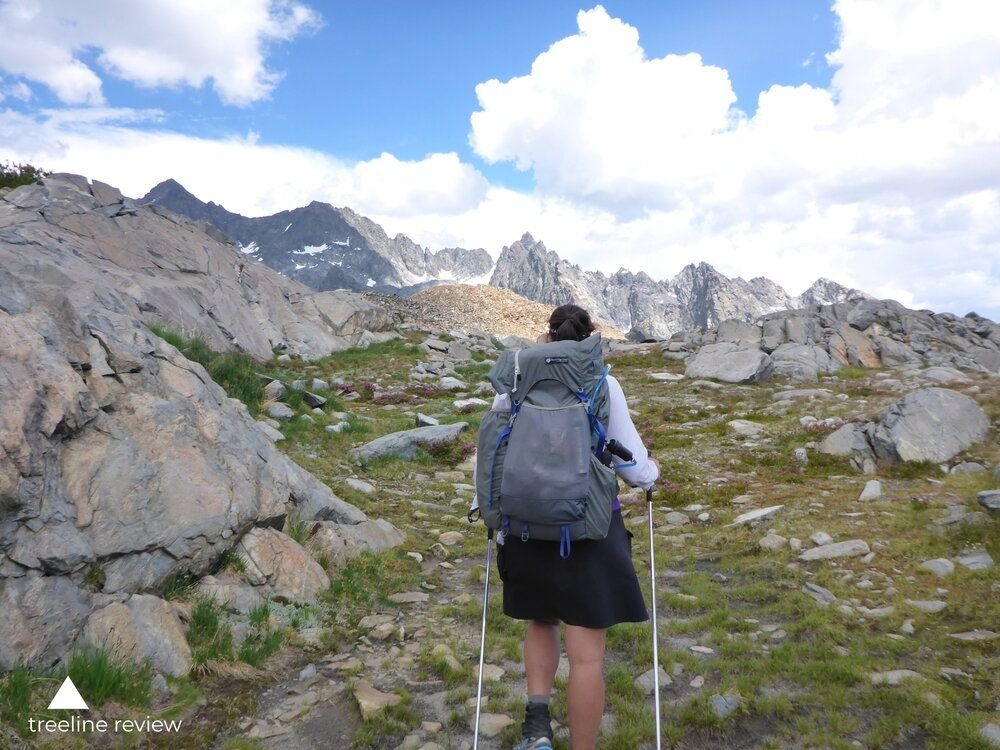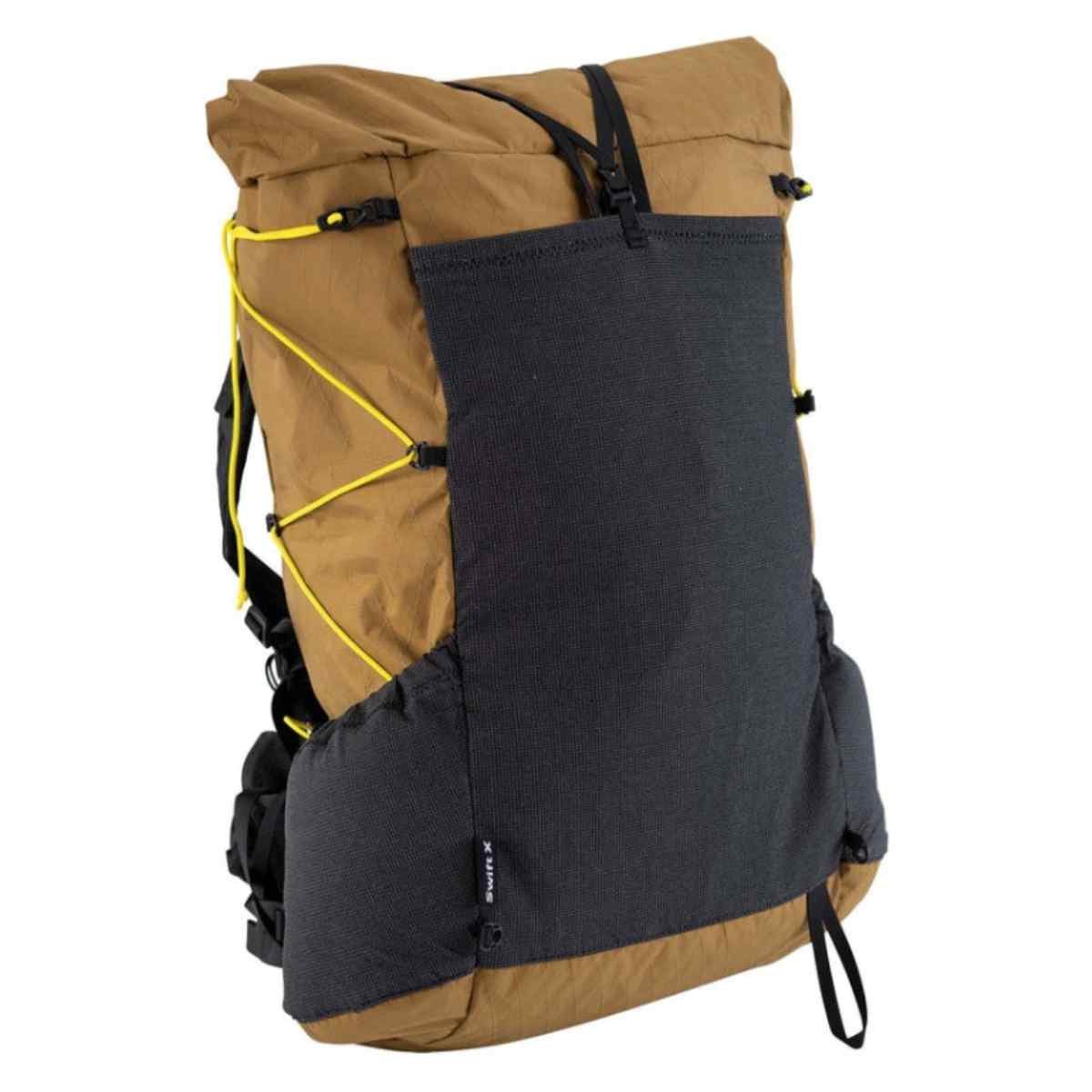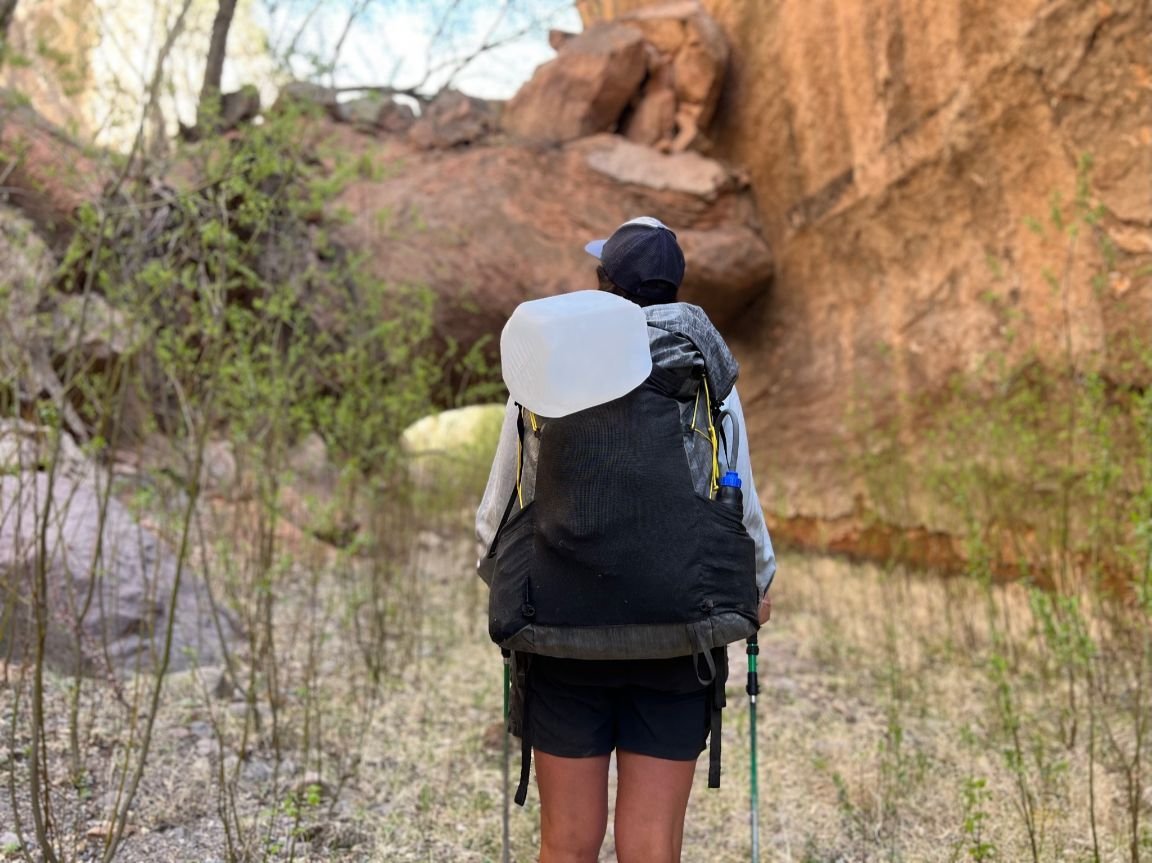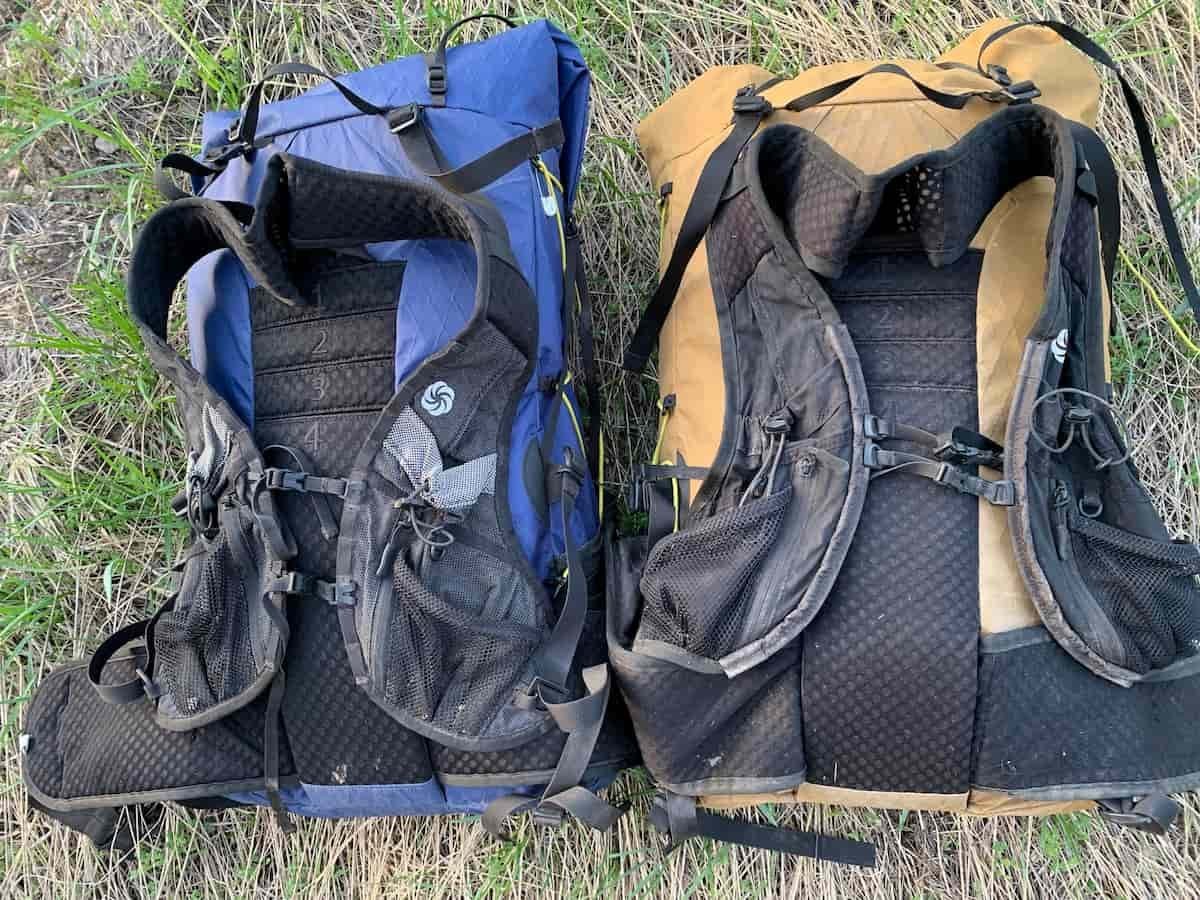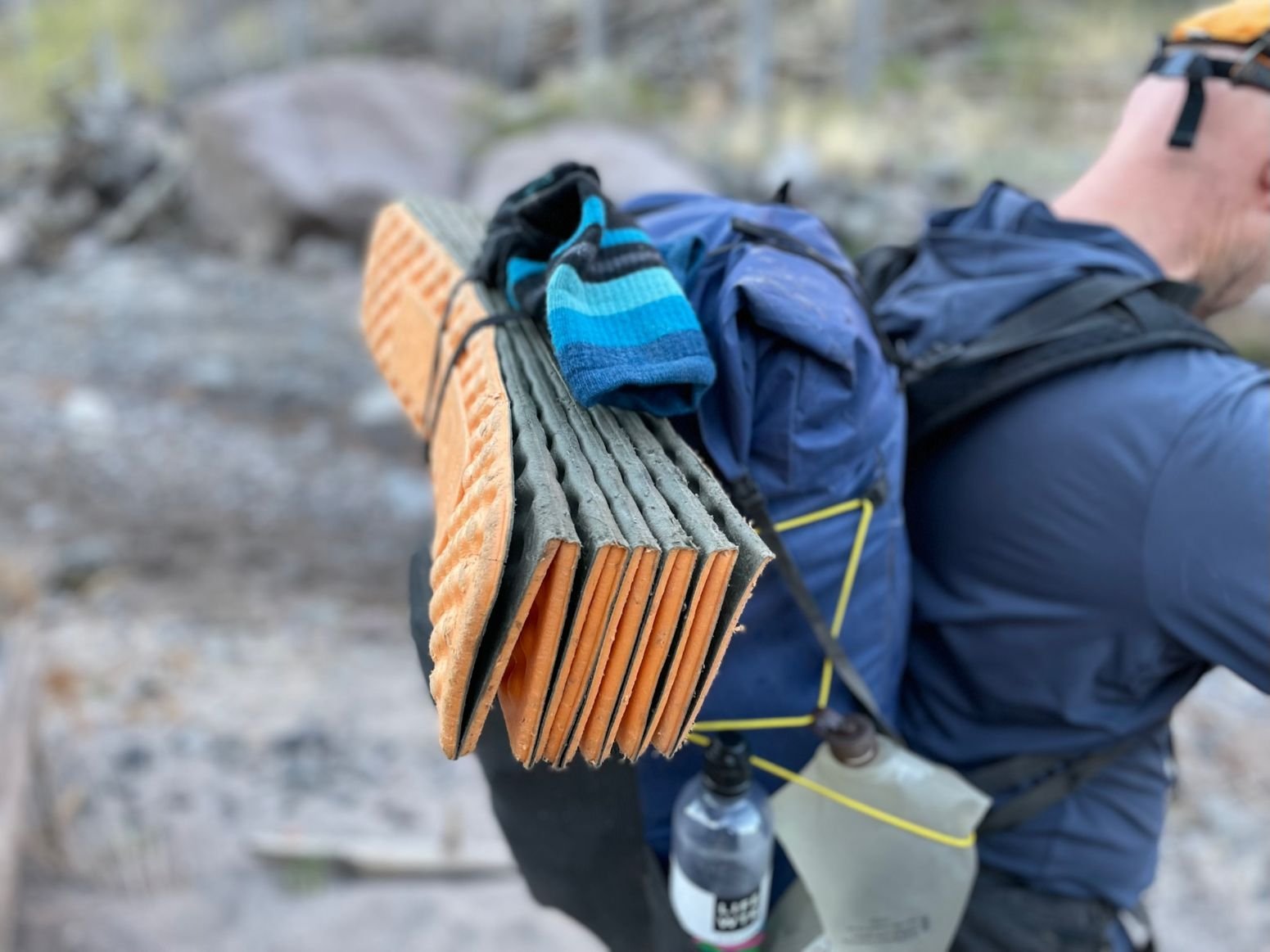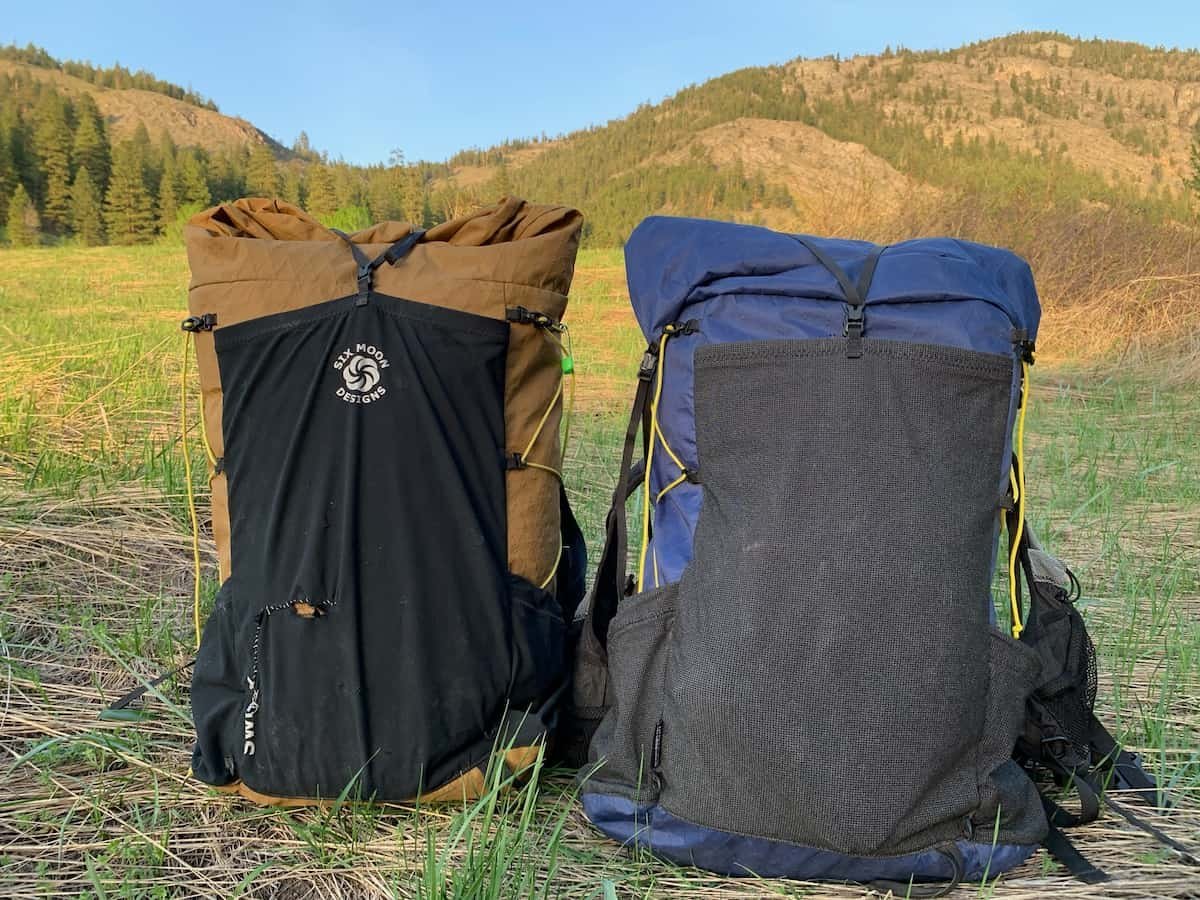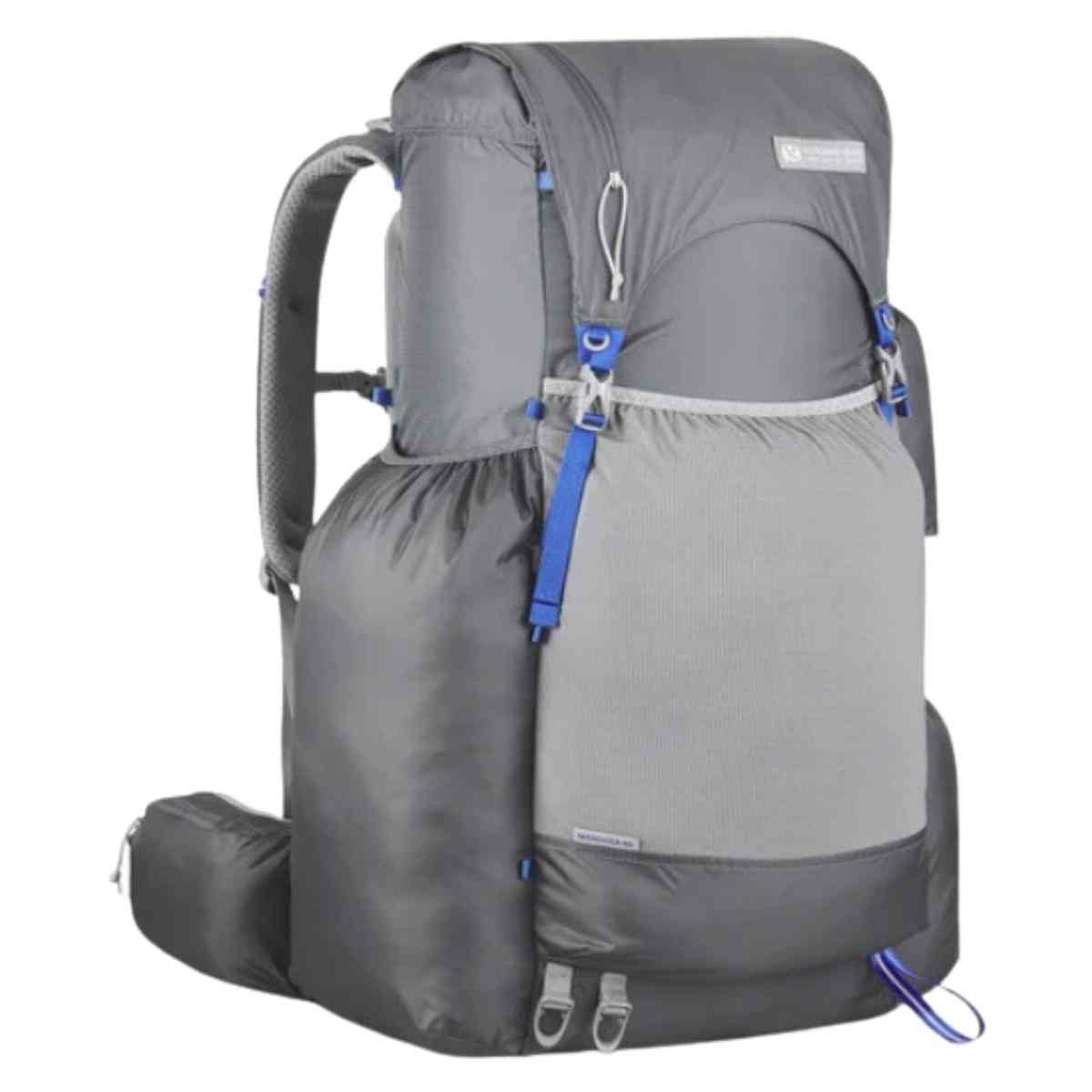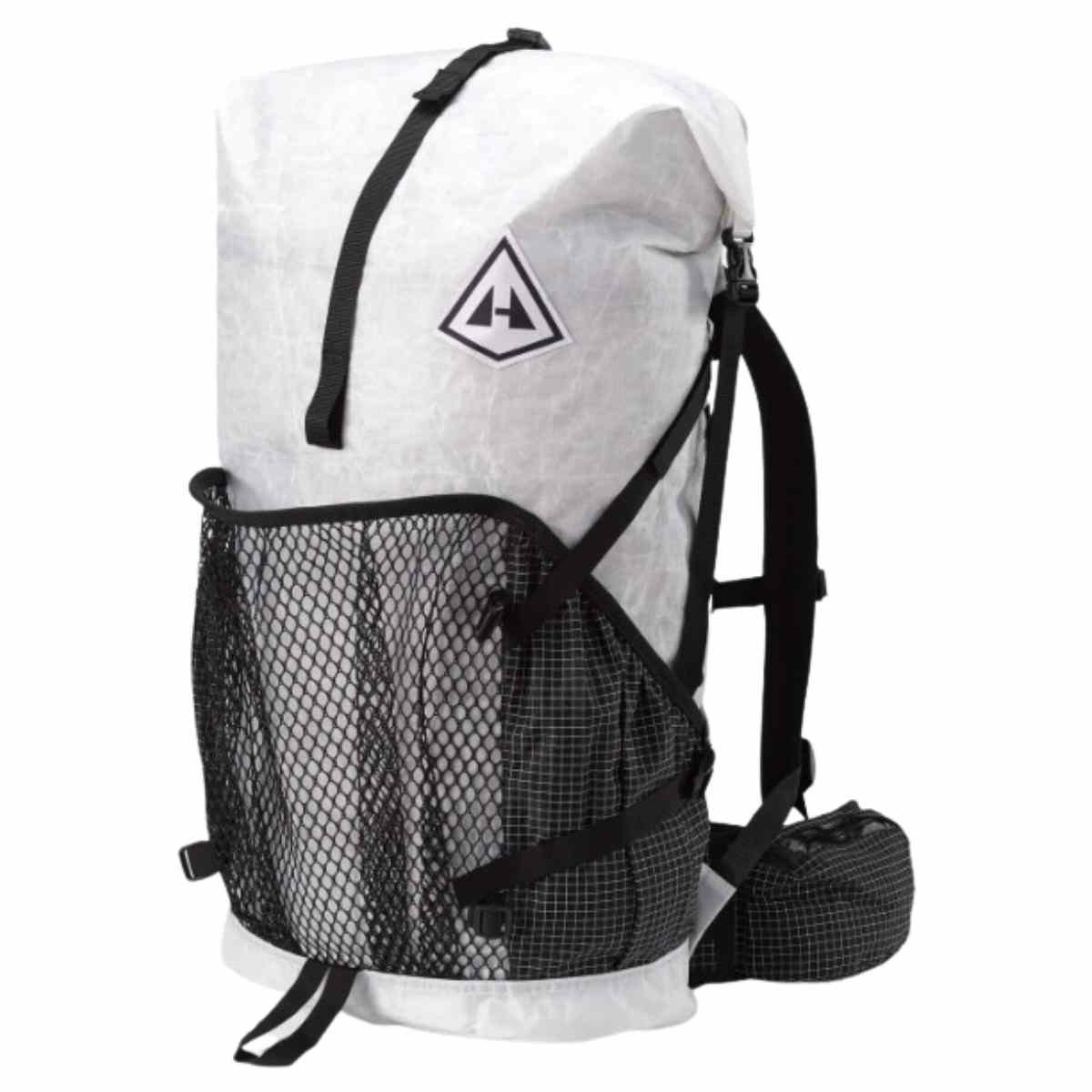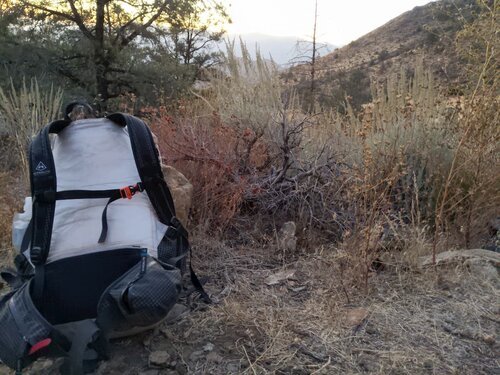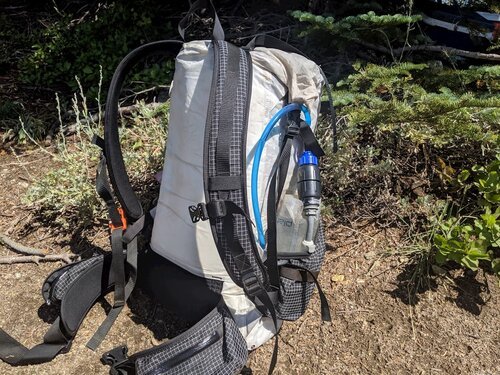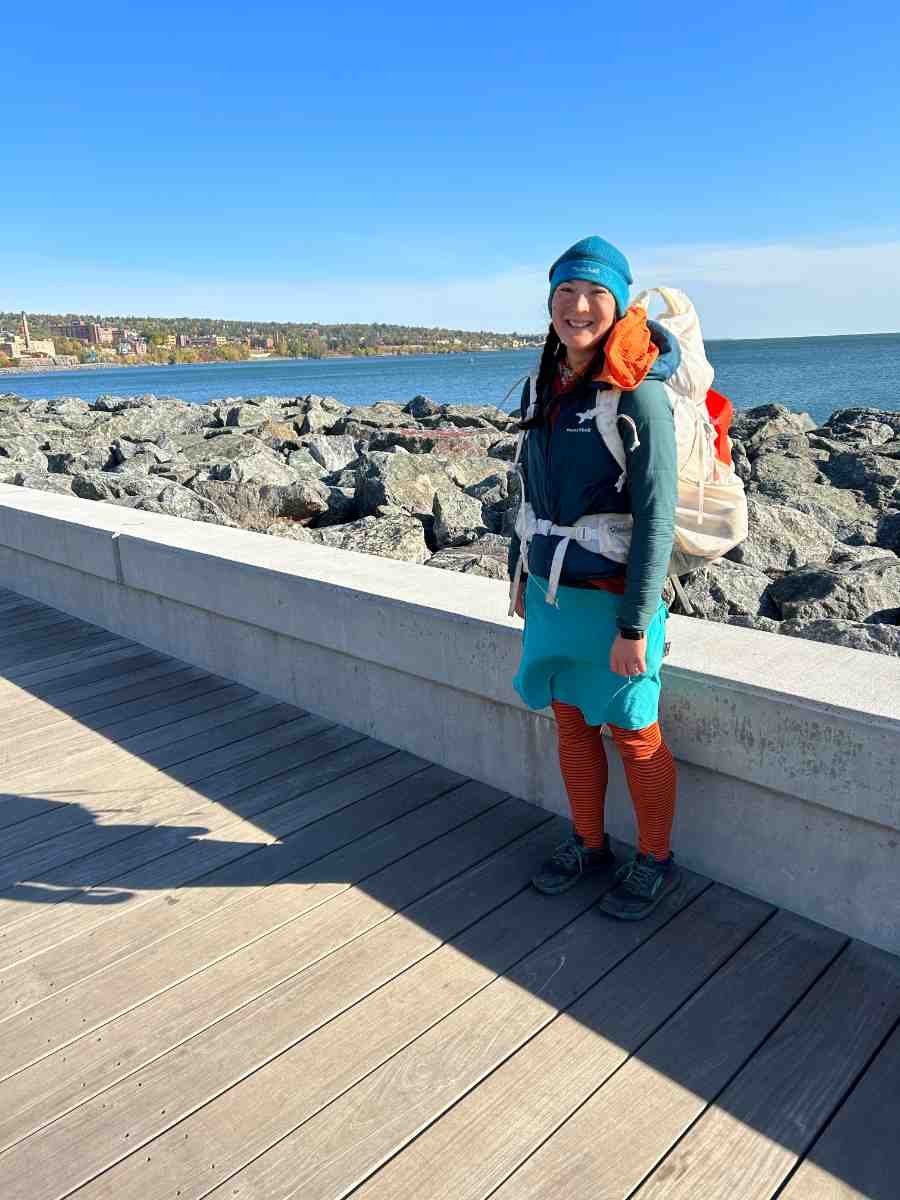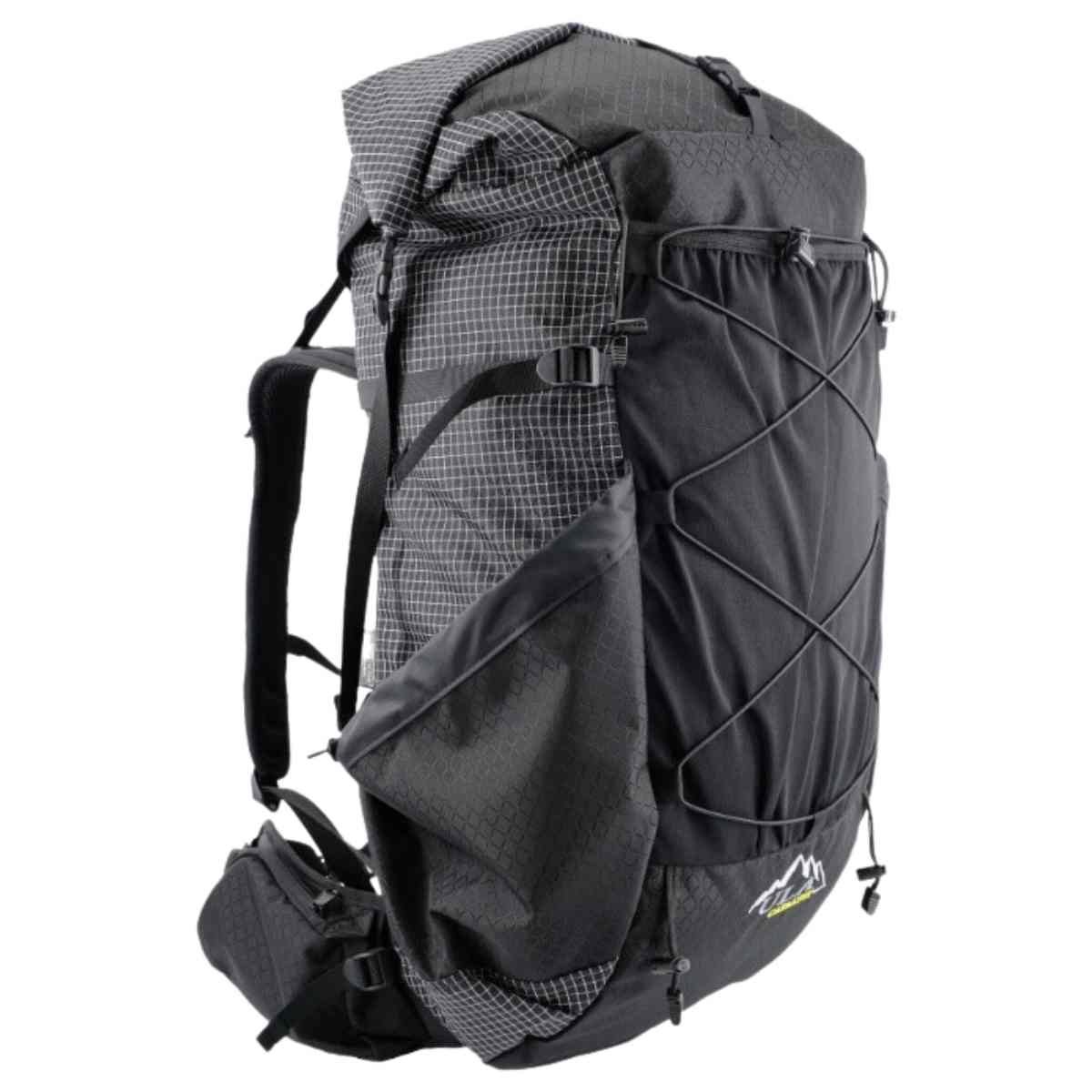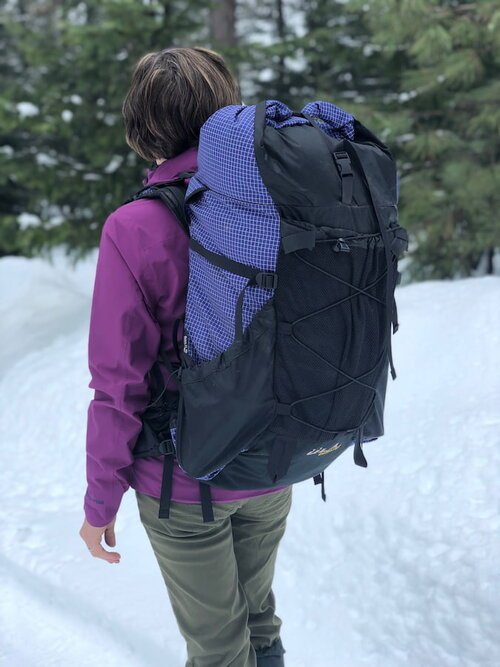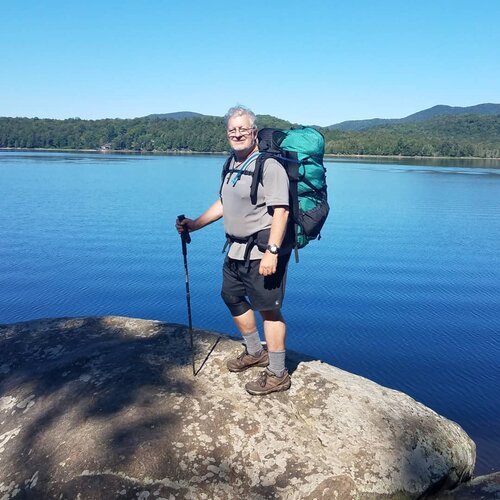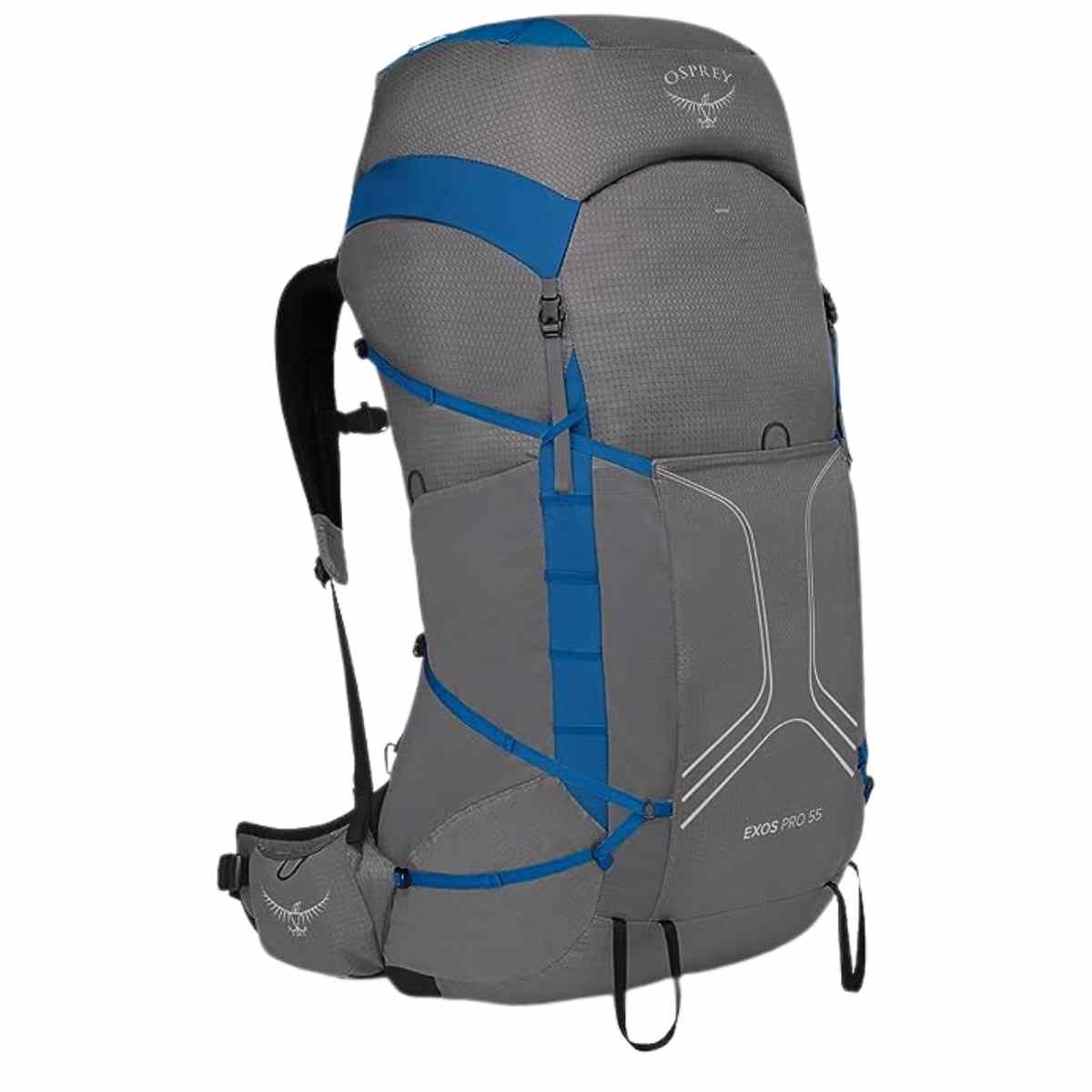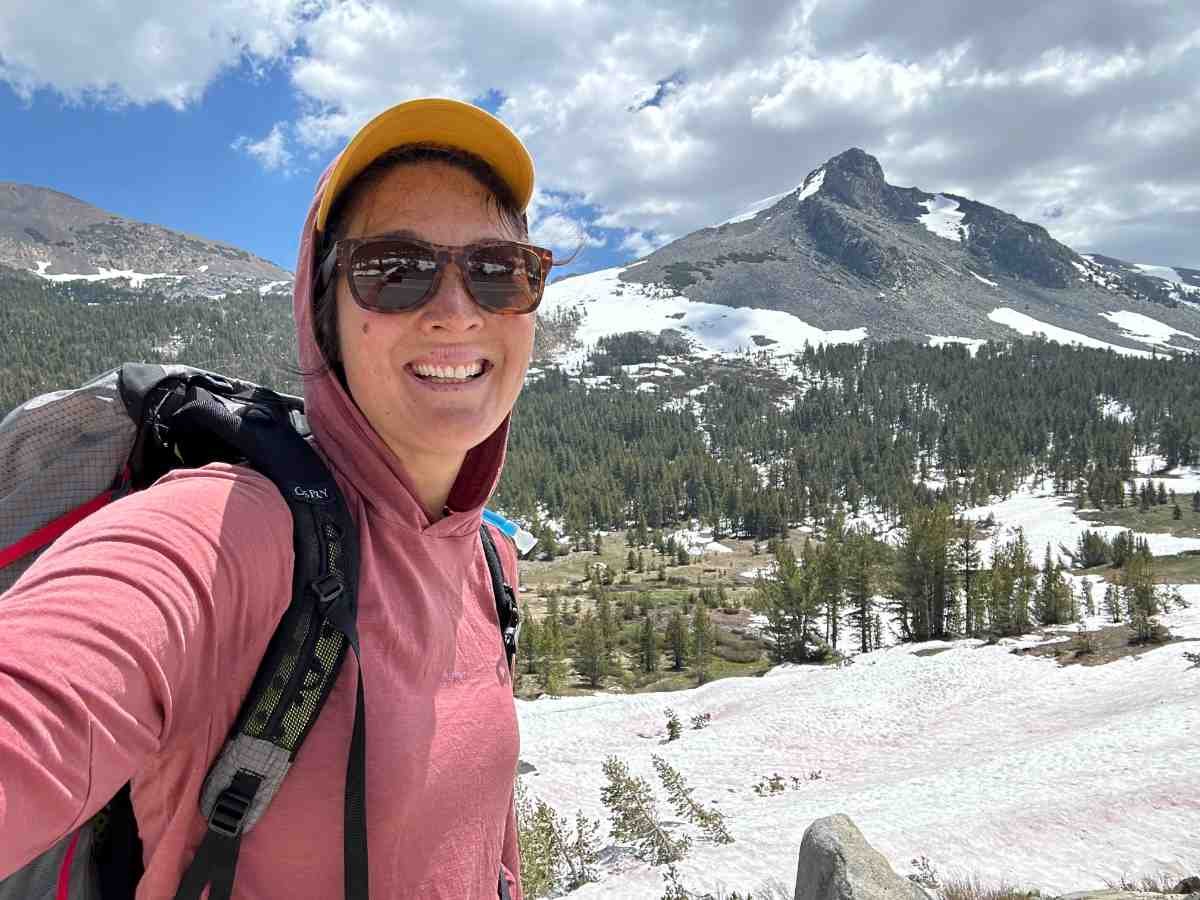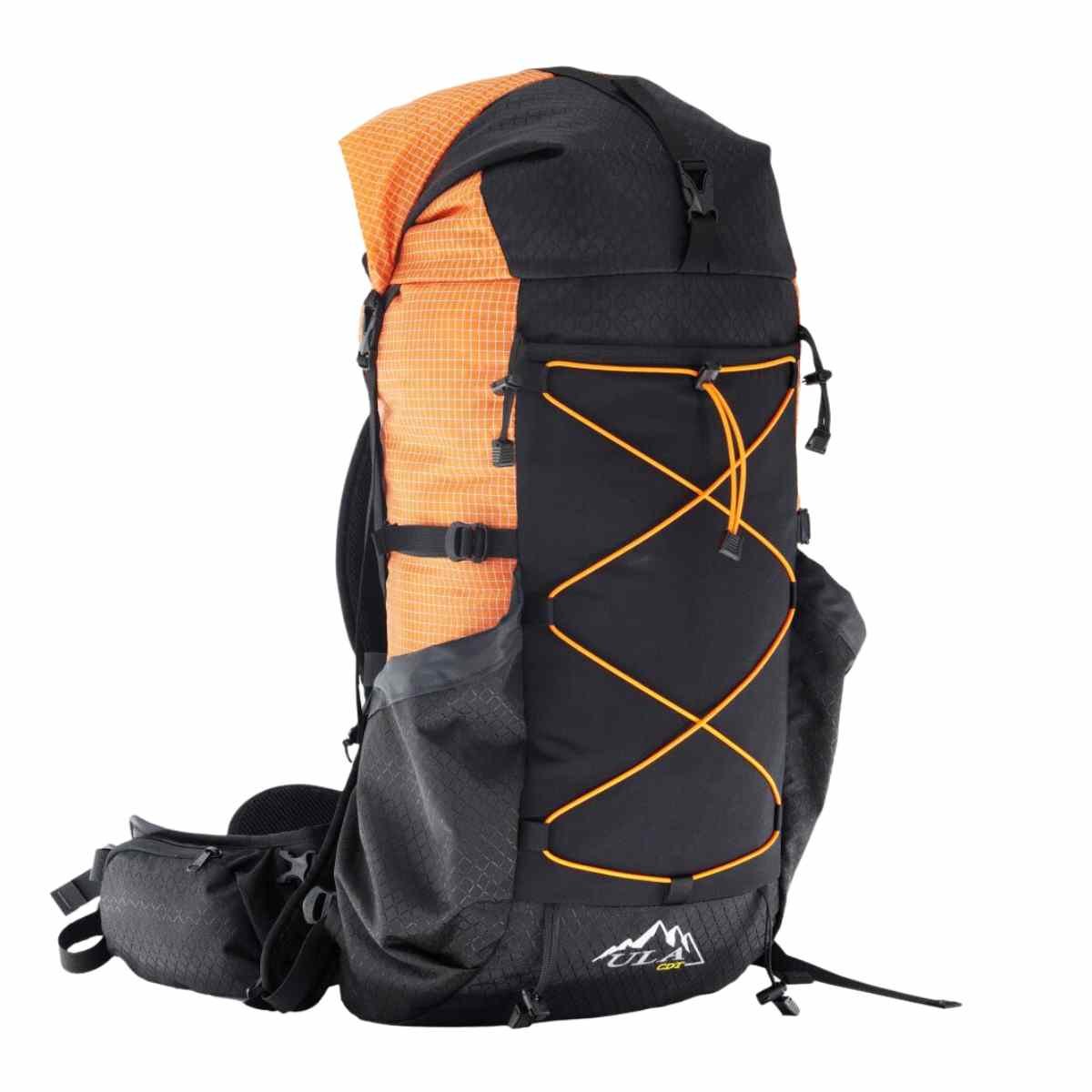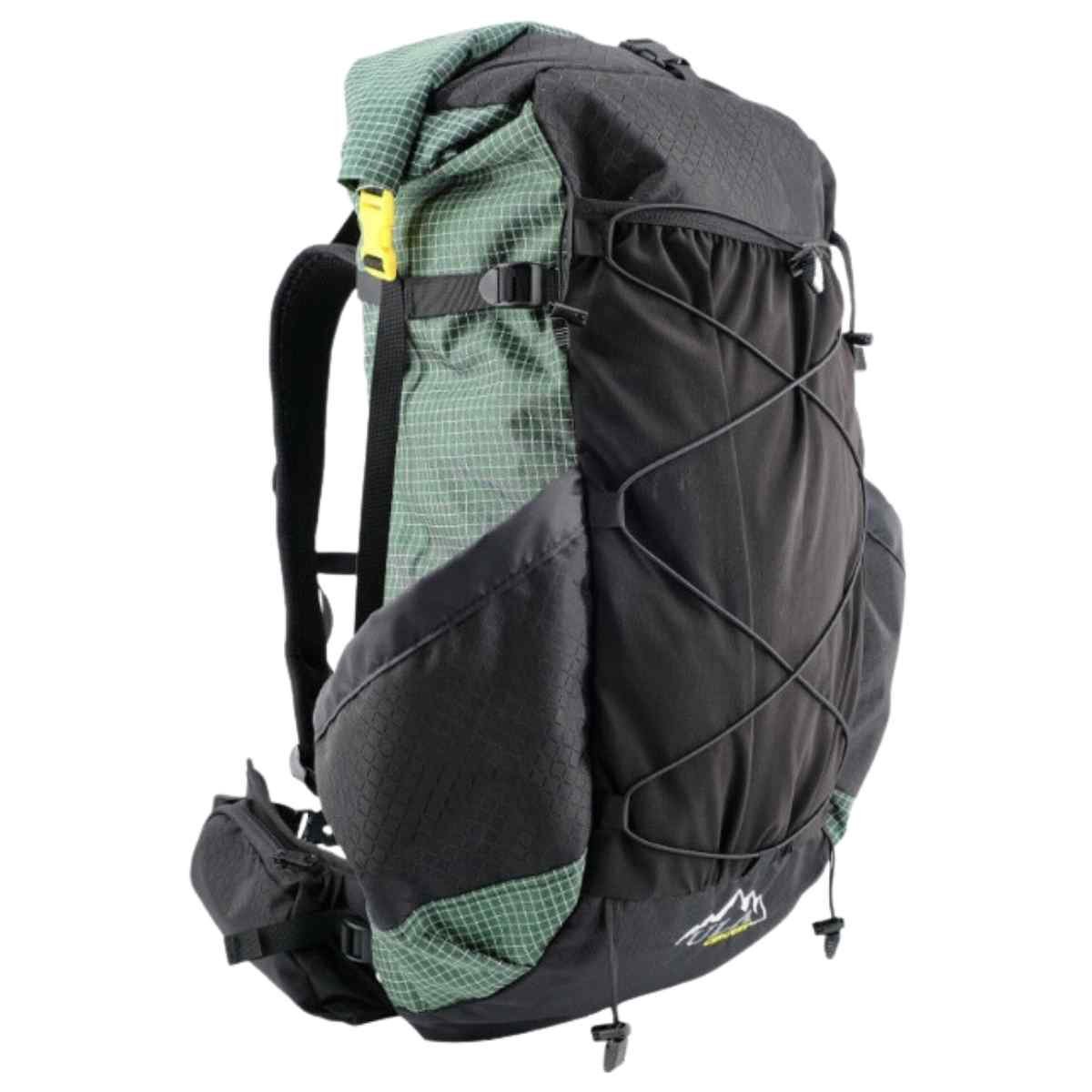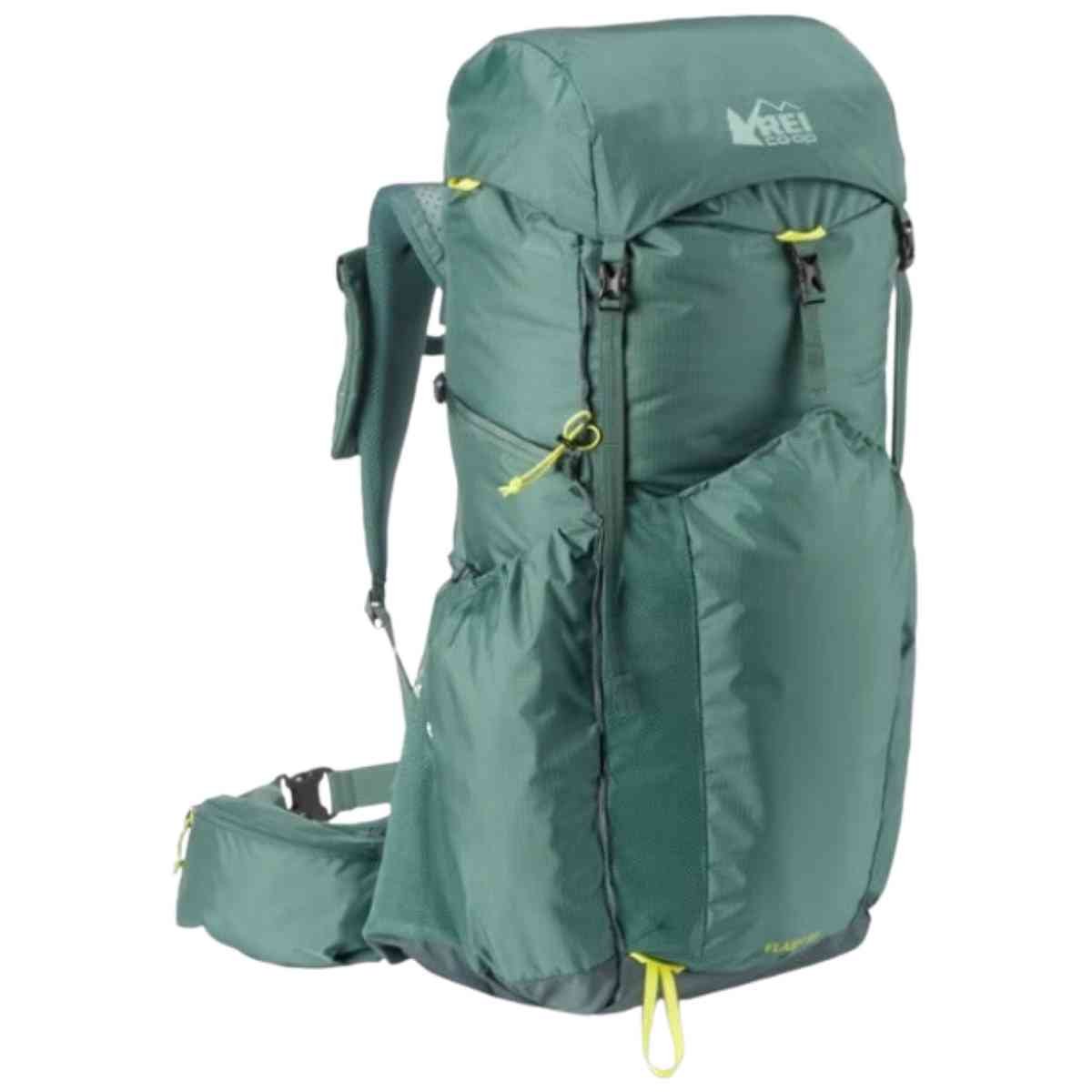Best Lightweight Backpacking & Thru Hiking Backpacks of 2023
THE TOP LIGHTWEIGHT AND ULTRALIGHT BACKPACKS FOR BACKPACKers and thru-hikers
August 9, 2023
To identify the best lightweight and ultralight backpacking backpacks, we backpacked thousands of miles in dozens of backpacks. We also interviewed backpackers from weekend warriors to world-class long distance thru-hikers to identify the best backpacking backpacks for most hikers, looking at capacity, weight, and price.
A backpack is arguably a backpacker’s most important piece of hiking gear. Ideally, your backpack becomes an extension of your body instead of a painful burden. Over the years, innovative backpack manufactures have revolutionized the outdoor industry. It’s no longer necessary (or desirable) to carry around a five to seven-pound backpack long distances. Now, the best backpacking backpacks weigh around two pounds and have enough carrying capacity for multi-day trips.
After hiking thousands of miles testing packs, we whittled our list of 17 contenders down to the top seven backpacking backpacks specific to most people’s needs. With our advice, you’ll know how to choose a modern, lightweight backpack to serve your backpacking and thru-hiking adventures of all lengths.
We create reader-supported, objective gear reviews independently selected by our editors. This story may contain affiliate links, which help fund our website. When you click on the links to purchase gear, we may get a commission — without costing you an extra cent. Thank you for supporting our work and mission of outdoor coverage for every body! Learn more.
BACKPACK COMPARISON TABLE
| BACKPACKING BACKPACK | TREELINE AWARD | MSRP | VOLUME (L) | MATERIALS | WEIGHT (LBS) | MAX LOAD (LBS) |
|---|---|---|---|---|---|---|
| Six Moon Designs Swift X | Best overall Read why |
$375 | 56 | LiteSkin LS21 or EPX 200 | 2.4 | 35 |
| Gossamer Gear Mariposa | Best for thru-hiking Read why |
$285 | 60 | 100 & 200 denier Robic high-tensil strength nylon | 2.0 | 35 |
| Hyperlite Mountain Gear Junction | Best dyneema Read why |
$349 | 50 | White: DCH50 (Main Body) & DCH150 (Bottom) Black: DCH150 (Main Body & Bottom) | White: 1.9 Black: 2.0 | 40 |
| Granite Gear Crown3 60 (men's) | Best budget Read why |
$240 | 60 | Robic® High-tenacity nylon (100D and 210D) with Barrier DWR | 2.4 | 35 |
| Granite Gear Crown3 60 (women's) | Best women's budget Read why |
$240 | 60 | Robic® High-tenacity nylon (100D and 210D) with Barrier DWR | 2.4 | 35 |
Looking for a day hiking backpack? Check out our Best Day Packs for Hiking Guide
Curious about pack volume? See How Accurate are Stated Volumes of Backpacking Backpacks?
Interested in backpacking gear? See our Backpacking section for our most popular stories.
The author testing the Swift X on the Blue Mountains Trail. Photo by Naomi Hudetz.
The Best Lightweight Backpacking Backpacks
THE BEST LIGHTWEIGHT BACKPACK:
SIX MOON DESIGNS SWIFT X
Capacity: 49L
Weight: 2.175 lbs
Cost: $270
Materials: LiteSkin LS21 or EPX 200
Cost: $375
What we liked: carries heavy loads, lightweight for its capabilities
What we didn't like: heavier than most other packs we tested
After 1,000 miles and a year of testing, we can say the Six Moon Designs Swift X is the best overall backpack for most backpackers. The Swift X is great for those transitioning from a traditional 5+ pound pack, but also ultralight backpackers on remote routes with long food and water carries like the Oregon Desert Trail or Blue Mountains Trail. In particular, we were impressed by the Swift X’s excellent suspension system that can comfortably carry heavy loads. The Swift X offers all the utility, comfort, volume, and durability of a heavier, traditional pack — but at half the weight.
VIEW THE SIX MOON DESIGNS SWIFT X
The Swift X’s stand out feature is the suspension feature. Photo by Naomi Hudetz.
The Swift X’s suspension system puts it above other packs we considered. It also has an optional innovative vest system that securely holds the backpack to your core. Another feature we like is its full set of functional and easy-to-access pockets on the pack, hip belt, and shoulder harness.
Weight
One potential downside is the Swift X is not the lightest framed backpack. The Gossamer Gear Mariposa, Hyperlite Junction, Hyperlite Windrider, and Zpacks Arc Haul are lighter. However, for a weight difference of a candy bar or two, we think the Swift X has a better suspension system and better features than these other backpacks.
The Swift X is one of the most customizable packs we found. Photo by Naomi Hudetz.
Comfort
The value of the Swift X’s suspension feature was evident for me on my thru-hike of the Blue Mountains Trail (see Treeline’s trail guide to the Blue Mountains Trail).
The Blue Mountains Trail required large food and water carries that pushed up against, and probably exceeded, the pack’s 35 pound recommended max load. Unlike other packs we tested, the Swift X alone carries that amount of weight comfortably. The vest harness system held the pack securely to my body when negotiating difficult trail conditions like deadfall, rock scrambles, creek fords, and overgrown brush. This was one of the most challenging routes I’ve hiked, and the Swift X performed beautifully. (Editor’s note: see Why You Should Trust Mike Unger below to see the other routes he has hiked).
Comparison of the fit and suspension system on the old Swift X (right) and new Swift X (left).
FIT & SUSPENSION
The Swift X’s fit and suspension system is one of its stand-out features. Ron Moak, the owner of Six Moon Designs, told us his packs are designed to comfortably carry any load you can fit in the backpack.
An internal Delrin hoop stay frame connects directly to the hip belt to better transfer the pack weight to your hips. We further discuss how to fine-tune your fit in our story on How to Choose Backpacks.
The Swift X is one of the most customizable packs we’ve encountered. But like any customizable item, it will be more comfortable if it fits you well and in order to fit you well, you need to take the time to get your measurements. We recommend reading their pack fitting page before you purchase. We’ve also found their customer service to be helpful and responsive in walking us through the steps of getting the perfect fit for the Swift.
The following are fit and suspension details:
Multiple Harness Options. The Swift X is unique for its three harness options: a vest, traditional shoulder harness, or an S-curve shoulder strap. We explain the harness options below.
Minimal Contact Back Panel. This is an important feature for long-distance hikes or hiking in hot and muggy conditions.
Adjustable Dual Sternum Straps. All harness systems have dual sternum straps that adjust to fit your chest.
Adjustable Torso Length. The Swift X comes in one size, but the torso length can be adjusted from 16” - 22”.
Removable Frame. The hoop stay frame can be removed, converting the Swift X into a frameless ultralight backpack. When frameless, the manufacturer recommends a maximum 25-pound load.
We were impressed with the Swift X’s stability, which proved itself valuable on cross-country bushwhacking and in getting around blowdown trees. Photo by Naomi Hudetz.
FEATURES
The following features make the Swift X stand out against other packs we considered:
Large Front Woven Pocket
The Swift X’s large, stretchy front pockets add several liters of additional volume. A large front pocket is useful when you need to temporarily accommodate gear outside your backpack, such as when packing a wet tent. It is also a convenient place to store items you want to access without opening your pack, like rain gear or lunch.
The author on the Northern New Mexico Loop with the Swift X. Side compression cords help manage the volume of the pack. You can secure items to the outside of your pack, such as drying clothes, seen here. We recommend doing so with diaper pins.
Side Pockets
The woven side pockets are stretchy, and each is big enough for two water bottles. The side pockets can be cinched tight to hold water bottles or other items securely.
Hip Belt Pockets
There are two large pockets on the hip belt. These pockets are big enough for a phone, camera, or snacks.
Removable Hydration Sleeve and Dual Hydration Ports
There are loops to secure the drinking tube to either shoulder strap.
Trekking Pole and Ice Axe Attachment Loop
Your trekking poles and ice axe can be securely attached to the back of the pack. (Need poles? Read our guide here).
Adaptability
The hip belt and hoop stay can be removed, converting the Swift X into a frameless pack.
Internal Stash Pocket
The Swift has a zippered internal pocket that is perfect for safely storing a wallet or keys.
Side Cord Compression System
The cords help stabilize your load and provide a convenient place to secure wet clothes.
Comparison of the old Swift X (left) with the new Swift X (right). The mesh has changed as well as the side pockets.
Updates on the Swift X
At the end of last year, Six Moons Designs updated the Swift X and made the following improvements. We first announced them in our Gear News a few months ago.
BIGGER STASH POCKET
The size of the internal zippered stash pocket has been significantly increased. It is now large enough to fit a passport, which is useful for folks traveling internationally.
REDESIGNED TOP ENCLOSURE
The Swift X now has two ways to close the top enclosure: 1) a roll top closure (like a dry bag closure system); or 2) side straps. The side strap method is better when using the main body’s extension collar.
IMPROVED STERNUM STRAP
The vest’s dual sternum straps are now a fixed daisy chain instead of a sliding strap. The daisy chain method will help prevent the sternum straps from sliding out of place and improve the fit.
The bottom line
Whether you’re new to backpacking, looking to lighten up from a traditional backpacking backpack, or a seasoned athlete with heavy water and food carries, the Swift X is a comfortable pack with the features you need to do what you want to do outdoors. For more, check out our Six Moon Designs Swift X Backpack Review.
The Mariposa on the Sierra High Route with a hydration system in the right water bottle pocket and rain gear (yellow) in the mesh pocket. Photo by Liz Thomas
BEST BACKPACKING BACKPACK FOR THRU-HIKING:
GOSSAMER GEAR MARIPOSA
Capacity: 60L
Weight: 1.9 lbs
Materials: 100 & 200 denier Robic high-tensil strength nylon
Cost: $285
What we liked: lightweight, durable, comfortable
What we didn't like: suspension capabilities not as strong as Swift X
The Gossamer Gear Mariposa is the best lightweight backpacking backpack for thru-hiking. Although the bestselling Mariposa qualifies as an ultralight pack, it offers backpackers all the utility, comfort, volume, and durability of a heavier, traditional pack at a fraction of the weight. Its intuitive, easy-to-use design and extra padding tipped it ahead of other backpacks in its weight class. The Mariposa is a multi-year bestseller for a reason with years of data and thousands of happy thru-hikers.
COMPARE PRICES OF THE GOSSAMER GEAR MARIPOSA
The Gossamer Gear Mariposa has long been a favorite of long-distance hikers. The annual PCT survey reports that it has been one of the top five most popular packs for Pacific Crest Trail (PCT) hikers for the last three years, with a greater than 90% satisfaction rate.
Professional and customer reviewers find that despite its two-pound weight, it can carry up to 35 pounds, which is a good weight range for most thru-hikes. However, we think the Swift X carries more comfortably for trips where you expect to be near that limit regularly, like many thru-hiking routes including the Oregon Desert Trail and Blue Mountains Trail.
The Mariposa has 60 liters of capacity, which is more than enough volume for multi-day adventures, including the longest carries in the Sierra on the Pacific Crest Trail, 100-mile wilderness on the Appalachian Trail, and the Bob Marshall Wilderness on the Continental Divide Trail. Backpackers especially liked its large, easy-to-access pockets that are free of common failure points like zippers or pull-ties.
The Mariposa is secure and balanced for when you travel on uneven ground. Photo by Liz Thomas
FIT/SUSPENSION
The Mariposa is a unisex pack that comes in three torso sizes (encompassing 17.25” to 23.5”) and three hip belt sizes (encompassing 22” to 50”) to accommodate a variety of body sizes.
Its suspension system is designed to carry up to 35-pound loads. The following are the key elements of the Mariposa’s fit and suspension system:
Hip Belt
Wider than found on most lightweight packs, the Mariposa's belt is well cushioned for a snug and secure fit. It's sized separately from the pack in order to customize the fit. The hip belts are sized as follows: Small (22”-32”), Medium (28”-45”), and Large (32”-50”). Since our last guide, the Mariposa now includes a Medium hip belt; the Small and Large sizes are sold separately.
Frame
The Mariposa integrates the frame stay into the hip belt to improve weight transfer to your hips. The pack also comes with a removable sit pad to provide a cushion for your back. You also have the ability to upgrade to an Air Flow pad or replace your sit pad should you accidentally sit somewhere you wish you hadn’t.
Shoulder Straps
We found the Mariposa’s shoulder straps to be wider and more comfortable than most of the packs we considered. The unisex straps are 3” wide and extremely cushioned. Unlike many two-pound packs, it has integrated load lifters to customize the fit, as well as a sternum strap with an integrated whistle. While we wish it had integrated mesh phone pockets like that found on Gossamer Gear’s Vagabond daypack and Kumo 36 Backpack, the Mariposa has the ability to add shoulder strap pockets. We further discuss how to fine tune your fit in our story on How to Choose a Backpacking Backpacks.
A favorite feature of the Mariposa is the left side pocket (visible in this photo). It can fit a two-person tent or other items you may want to store on the outside of your pack. Photo by Liz Thomas.
FEATURES
The following features distinguish the Mariposa from the other backpacks we considered.
Removable sit pad
A removable sit pad comes with the pack and is used as part of the pack’s frame. We’re noting it again because we really like this dual-use item — and it’s a feature not found in any of the other packs we considered. The sit pad is easy to take out and put back into the frame during breaks on backpacking trips — and you can use it as an additional sleeping pad at night. If you don’t like the standard sit pad, you can upgrade to the Air Flow sit pad.
The Mariposa has trekking pole and ice axe attachment loops on the bottom. The stretchy mesh can fit many items you may want to easily access throughout the day, like snacks. Photo by Liz Thomas
Large Mesh Front Pocket
Gossamer Gear’s mesh is considered among the stretchiest in the pack industry, which is useful when you need to temporarily accommodate a lot of gear on the outside of your bag, or you need to store wet gear separate from your dry items (such as when packing out a wet tent). A good mesh front pocket is essential for items you want to access without opening your bag, like rain gear, maps, or lunch.
Side Pockets
Unlike any other pack we considered, the Mariposa has three side pockets. On the right side is a water bottle pocket, big enough for two 1 liter bottles. Above the water bottle pocket is an 8” wide x 10” tall pocket, where some people keep their cookware or other items that are voluminous but lightweight. On the left side is an 8” wide x 16” tall pocket that would be great for a small tent (we were able to fit a Zpacks Duplex tent without its stuff sack into this pocket).
Another minor issue is that there is not a great place to hold a full-size umbrella (popular with many hikers for sun and rain protection). The umbrella will fit in the large side pocket, but there is no side compression strap or cord to secure items that stick out above the pocket.
Hip Belt Pocket
Larger than on other lightweight packs we considered, the pockets are integrated right into the hip belt. Integrated sewn-in pockets are beneficial because they won't slide or fall off should a plastic attachment come loose, as can happen with optional pocket attachments. Large pockets are also a huge bonus when backpacking as you can access your phone/GPS, camera, snacks, and/or maps without having to stop and remove your pack.
Over The Top Closure System
The Mariposa’s top closure system securely covers the pack’s main compartment and has a zippered pocket. The zippered pocket on top makes it easy to access items like a first-aid kit, where you always want to know where it is, but also want it out of the way most of the time.
Trekking Pole and Ice Axe Attachment Loops
Your hiking poles and ice axe can be securely attached to the front of the pack.
Water Bladder Sleeve
There are loops to secure the drinking tube to either shoulder strap.
Adaptability
The hip belt, frame, and sit pad (back support) can be easily removed converting the pack into a frameless pack weighing close to one pound. This is weight-wise on par with our frameless pack pick, the Mountain Laurel Designs Prophet. However, we think the Mariposa best use is as a framed backpack.
Who else likes it
It’s the top-rated ultralight backpack on Switchback Travel and Greenbelly. Section Hiker ranks the Mariposa as a top ultralight pack. Outdoor Gear Lab, when reviewing ultralight backpacks, rated it the #1 pack (of 20) for comfort, durability, and features.
The bottom line
The Mariposa is a bestselling favorite backpacking backpack loved by customers and professional reviewers alike.
The HMG Junction backpack at Kearsarge Lakes in the Sierra. Photo by Naomi Hudetz.
Best Dyneema Backpacking Backpack:
HYPERLITE MOUNTAIN GEAR JUNCTION
Capacity: 50L
Weight: 1.88 lbs
Materials: White: DCH50 (Main Body) & DCH150 (Bottom)
Black: DCH150 (Main Body & Bottom)
Cost: $349
What we liked: overall durability, water resistance
What we didn't like: issues with durability of the mesh
The Hyperlite Mountain Gear Junction is the best Dyneema backpacking pack available because of its balance of quality, durability, and water resistance. Hyperlite Mountain Gear is a small, outdoor gear manufacturer in Maine that makes all of its gear in the US. We found that HMG backpacks are made with an attention to detail that makes it worth paying a premium for their gear. IThe ultralight Junction backpacks — available in 2400 and 3400 cubic inches sizes — became our Dyneema winner because of its ease of use and well-designed pockets.
While not everyone will want a backpack made of Dyneema Composite fabric (formerly known as cuben fiber fabric), many backpackers find it to be a top priority. DCF is a rugged sailcloth that is abrasion-resistant and waterproof enough to be the fly on a three-season tent (more on how waterproofing is measured here).
VIEW THE HMG JUNCTION BACKPACK
2400 CU
3400 CU
We tested the Windrider on a thru-hike of the Ouachita Trail. Photo by Mike Unger.
One store that sells DCF fabric by the yard claims that it has a strength-to-weight ratio that is 15 times stronger than steel.
The three HMG packs we considered (the Junction, Southwest, and Windrider) are made of Dyneema Composite Hybrid Fabric, which is similar to DCF but has an even higher resistance to abrasion, UV, and chemicals.
We like the DCH fabric on the Junction (also found on the Junction and Windrider) because it is waterproof, puncture-resistant, and resistant to abrasion. But more importantly, unlike other brands including Six Moons, HMG seam seals over 90% of their seams. While HMG warns that the pack is not 100% waterproof, our Junction kept our gear dry after months of day-to-day use in rain, hail, snow, and the “car wash effect” (when wet brush gets you wet while hiking, even when it isn’t raining).
Liz Thomas wearing the HMG Junction in northern California on the PCT. Photo courtesy Liz Thomas.
We know many people who have gotten multiple 2,000+ mile thru-hikes out of their HMG packs (we put in 1,000 miles on the Junction with barely any signs of use). That balance of weight and performance is one reason why this fabric has become quite popular for use in backpacks.
While HMG is not the first backpack manufacturer to use the DCH fabric, they do more volume in DCF and DCH backpacks than any other company. That volume has allowed HMG to refine the process to an art.
While HMG’s Windrider and Southwest have been ultralight thru-hiker standards for several years. After testing different models on a few thru-hikes, we recommend their newest model released in 2019, the Junction. The Junction’s design is a combo of the best of the Southwest and Windrider — and before it existed as its own model, a design similar to the Junction was one of the most popular custom design requests.
Like the Windrider, the Junction features a mesh front pocket that makes it easy to dry out gear like wet socks.
Like the Southwest, the Junction has solid fabric side pockets that keep water bottles or water bladders and filters in place better than the other models. Those pockets are also more durable when bushwhacking or walking on narrow, overgrown trails.
The HMG Junction on the PCT near Mt. Ashland. Photo by Liz Thomas
The Junction is available in two sizes: 2400 c.u. and 3400 c.u. capacity (40 L and 55 L, respectively). Each pack has a 600 c.u (9.8 L) volume in external pockets. It has a minimalist frame that HMG says can handle 40 pounds (though, based on our testing, we’d err on the side of 30 pounds). The pack itself weighs under two pounds (30.12 oz for the white version; the black version uses a thicker fabric that brings the weight up to 31.8 oz).
Treeline co-founder Liz Thomas used the 2400 c.u. Junction on a late-season 1000-mile southbound section hike of the PCT. She had several long food carries, including one 160-mile section without resupply as well as days of rain and snow. She reports that the DCH fabric showed almost no visible signs of wear and remained waterproof. (Note: despite being waterproof, we strongly recommend you use additional methods to protect your gear. See our section on how to keep your gear dry).
Liz’s experience is consistent with users who we interviewed who had multiple thru-hikes on the HMG Windrider or Southwest; the Junction has been on the market for less than a year of thru-hiking (we’re not counting 2020), so we’re extrapolating durability based on the other models made of the same fabric.
Liz was impressed by the Junction’s quality construction and workmanship. It had no visible signs of wear other than discoloration — which of course happens with a white pack. Ironically, a dirty HMG pack has actually become a sign of pride among distance hikers.
The only noticeable wear on the HMG Junction we tested was two small punctures in the mesh fabric on the outside. But these small punctures were easily repaired with a piece of Tenacious Tape. (Note: we consider Tenacious Tape an essential item to carry on every backcountry trip. See our story on Essential Backpacking Accessories).
Still, while it isn’t enough to sway our decision, we find the mesh on the Gossamer Gear Mariposa to be much better suited for a backpacking backpack. The mesh is consistently considered the least favorite part of an HMG pack among users. Multiple long-term users we interviewed with thousands of miles and multiple thru-hikes on their HMG packs said that the mesh isn’t its strong point.
The HMG Junction on the PCT south of Kennedy Meadows, CA. Photo by Mike Unger.
FIT/SUSPENSION SYSTEM
The HMG Junction is a unisex pack that comes in four torso sizes. The belt comes in a single size fitting waists 28” and up (the small size pack fits 26” and up).
Frame
The Junction has contoured aluminum removable stays with a foam back panel pad. Compared to other DCF or DCH packs, like the Hyperlite Mountain Gear Southwest, I found that it kept my back relatively cool and handled the weight well.
Hip Belt
We found the hip belt pocket situation on the Junction to be on point. Our tester found the pockets to be the most generously sized pockets among the backpacking backpacks we considered. It easily held cameras, phones, snacks, sunscreens, and lip balms — no fanny pack required!
Shoulder Straps
The shoulder straps are padded with 3/8” closed cell foam and spacer mesh and a sternum strap/whistle.
No Load Lifters
HMG packs are designed to carry comfortably without load lifters, which is a point of contention among hikers. Some hikers — even lightweight or ultralight hikers — find a benefit to load lifters, saying they prevent shoulder knots and bruising. Others think they’re a relic of traditional backpacking backpacks. If you know you like load lifters, try the HMG pack fully loaded in your house before committing to it (don't worry — they have a great return policy).
The HMG Junction has DCH fabric lined side pockets and generous hipbelt pockets for storage. Photo by Liz Thomas
FEATURES
Roll Top Enclosure
The HMG Junction uses a multi-strapped compression top we found confusing at first, but once we got a hang of it we thought it was pretty clever. The roll-top closure system has side compression straps, which offer vertical compression. It also has a Y-strap compression that also adds to compression while also helping secure gear (such as if you were carrying a bear can on top). This Y-style of roll-top enclosure, also found on Mountain Laurel Designs packs, increases compression.
The roll-top enclosure is held together with Velcro. While Velcro is not an uncommon closure mechanism in a hiking pack (Zpacks also uses Velcro), we find that it easily gets caught on clothing items. Although they’re no longer in production, we miss the magnetic enclosures found in the Katabatic Onni, our upgrade pack from 2019.
Side Pockets
The pack has two large side pockets. Each pocket will hold two 1-liter Smartwater bottles plus some snacks. We were easily able to reach a water bottle while on the move. Straps also help cinch the pockets in place should you want to secure something, as we did with the Vargo Bot cookpot whose diameter was smaller than the pocket.
Mesh Front Pocket
There is a huge (9.8 liter) front pocket — one of the largest of any of the packs we considered. While the sizing of the pocket is great, HMG’s mesh is not very durable. In fact, it’s more like netting than mesh.
Compression Cords
Attachment Options
There is an ice axe attachment loop centered on the front of the pack. In addition, there are removable gear tethers on the shoulder straps for a water bottle or gear pouch. HMG has some of the best shoulder phone pockets available because they are waterproof, and lightweight, and secure easily to any pack (not just those made by HMG). However, we missed the built-in, minimalist (but not waterproof) phone pocket on the Gossamer Gear Mariposa’s shoulder strap.
HYPERLITE MOUNTAIN GEAR JUNCTION VS. HMG WINDRIDER
We tested the HMG Windrider on the thru-hike of the Ouachita Trail (see our Trip Guide to the Ouachita Trail). Like the Junction, it’s also available in 2400 and 3400 volumes, as well as a 4400 cu volume.
The main difference is the Windrider uses mesh for the front pocket and the side pockets whereas the Junction uses mesh in the front pocket only. We prefer the DCH fabric for side pockets. It’s a minor quip, but the sides are an area of the pack that is susceptible to rubbing against brush on narrow trails. The fabric found on the Junction adds some durability and more secure storage space.
The major drawback of the Junction compared to these other HMG packs is distribution. The Windrider is available at Backcountry and Garage Grown Gear, whereas you can only get the Junction at HMG’s website.
HYPERLITE MOUNTAIN GEAR JUNCTION VS. HMG SOUTHWEST
In researching this story, we also considered the Hyperlite Mountain Gear (HMG) Southwest. They’re very similar packs — also available in 2400 and 3400 cubic inch volumes. The main difference is that the Southwest uses a DCH front and side pocket compared to the Junction’s mesh. We think like many backpackers, the Junction’s mesh front pocket is more useful for drying gear. We also prefer the mesh front pocket of the Junction because it’s less likely to pool rainwater or trap pine needles and leaves. The major drawback of the Junction compared to these other HMG packs is distribution. The Southwest is available at REI, Backcountry, and Garage Grown Gear, whereas you can only get the Junction at HMG’s website.
The bottom line: We think the HMG Junction is the best Dyneema pack for most backpackers. While not everyone wants or needs a Dyneema pack, HMG has perfected the art of working in this fabric to create a pack that will serve you well on the long haul.
BEST BUDGET BACKPACKING BACKPACK:
GRANITE GEAR CROWN3 60
Capacity: 60L
Weight: 2.36 lbs
Materials: Robic® High-tenacity nylon (100D and 210D) with Barrier DWR
Cost: $240
What we liked: options to adjust weight, lots of features, great value for the price, undyed fabric available as an eco-friendly option
What we didn't like: doesn't use PFC-free DWR
Granite Gear Crown3 60 (men’s and women’s) is an excellent lightweight backpack — and at about $240 (and often found on sale for less), is a great value. The Crown3 has 60 liters of capacity, a 35-pound load rating, and weighs less than two and a half pounds. Despite its light weight, it has many of the features found in a traditional five-pound backpacking pack, including a plastic internal frame and well-padded shoulder straps. Best yet, with so many removable features, it is easily adaptable.
Our favorite feature of this pack is that as you learn to backpack with less weight, you can adapt this pack to be lighter. If you are interested in ditching the old five-pound pack and trying a more lightweight approach to multi-day backpacking, this could be the perfect pack. Treeline Review editor Liz Thomas used this pack in the undyed fabric for a thru-hike of the ~330-mile long Superior Hiking Trail and found it had all the comfort and features she wanted in a backpack at a fraction of the price of bigger name brands.
COMPARE PRICES OF THE GRANITE GEAR CROWN3 60
MEN'S
WOMEN'S
The generous mesh pocket on the Crown2 60 can be used to store items you need throughout the day without requiring you to open your backpack. The voluminous pack lid is removable. Photo by Mike Unger.
The Crown3 50 has the same generous mesh that can fit a multi-day food supply just on the outside of the pack. On the right, the pack is shown without the pack lid.
Granite Gear Crown3 60 vs Crown2 60
Updates to the Crown3 from the Crown2 includes a change to the frame sheet to allow for adding an aluminum stay to increase load capacity to up to 43 lbs. This is handy if you're thru-hiking a trail that usually doesn't require carrying 43 miles, but may have a few sections where you need an ice axe and bear can (like in the Sierra) or a few sections with heavier water carries (like Southern California on the PCT).
The Crown3 also now has a lid that can convert to a chest pack or fanny pack (when attached to the removable hip belt). This is a feature we really wish the Crown2 had so were delighted to see the update in the Crown3. The lid can be used when you backpack into a base camp but want a separate day pack/fanny pack for summiting a peak or exploring a lake. If you're on a thru-hike, you can also use this lid for a town bag.
We love the customizable lid update, but it’s worth noting that this means adding on a few ounces to the weight. To us, at least, it’s a small price to pay for the versatility.
The Crown3 60 is available in men’s and women’s versions. The women’s version is sized to fit hips and curvier bodies.
GENDERED FIT
Unlike many of the packs we considered, the Granite Gear Crown3 60 is available in men’s and women’s versions (see our gender-specific section of our How to Choose a Backpack guide for more information). Each version comes in three torso sizes and has a one-size, adjustable waist belt.
SUSPENSION
Frame
The Crown3 uses a molded plastic frame sheet that is integrated with the hip belt to transfer weight to your hips. The frame sheet can be removed to reduce overall weight by six ounces. There is also a foam back panel that is molded to allow airflow to reach your back.
Hip Belt
Thickly padded with large zippered pockets, this single-size hip belt is sized for 26” to 42” waists. It's made of Granite Gear’s patent-pending “Re-Fit” system to allow for precise sizing for different body types. In their review of the pack, Section Hiker found that the adjustable hip fit comfortably and did not slip or buckle under loads that exceeded the Crown3’s recommended 35-pound load limit. We also found the hip belt to be well-padded and appreciated the large zip pockets.
Shoulder Straps
The Crown3’s shoulder straps — slightly different on the men’s and women’s versions — are wide and thickly padded.
Load Lifters
We were happy to see the Crown3 60 has load lifters.
The Crown3 60 can easily fit an umbrella and trekking poles.
FEATURES
Removable Pack Lid
The Crown3 has a lid with a large zippered pocket. For those looking to reduce weight on their pack, the lid can be removed to reduce the pack’s weight by approximately two and a half ounces. With the lid removed, the main compartment features a roll-top opening with a buckle closure.
Side Pockets
There are stretch woven pockets on each side of the pack. The pockets are deep enough to accommodate tall water bottles (like Smartwater bottles). Side compression straps lower on the pack can be used to further secure items in the side pockets.
The Crown3 60 on the river walk Duluth section of the Superior Hiking Trail in Minnesota.
Front Pocket
The Crown3 has a large stretchy mesh pocket in the front of the pack that’s big enough to accommodate a wet tent or hiking gear.
Suspension Straps
The Crown3 has both front and side compression straps to allow you to carry less-than-full-volume loads more snugly. While we think the multitude of straps clutter the pack, customer reviews note that they are convenient for securing items like a Z-Lite Sol sleeping pad, snowshoes, or trekking poles (read our trekking poles guide here).
Hydration Sleeve
The pack has an internal sleeve for a hydration system. The hose port is located in the top center of the pack so the hose can be located on the right or left shoulder.
Adaptability
As we previously noted, the Granite Gear Crown3 60 has a removable lid (.16 lbs) and frame sheet (.38 lbs). The hip belt can also be removed (.41 lbs). While we think most users will want to keep these items intact, the adaptability means that if/when you ever want a lighter-weight frameless pack, you can modify your Crown3 instead of having to buy a new pack. The Crown3’s weight (regular torso size) can be reduced to less than a pound and a half — comparable to our frameless pack recommendations. That said, you’ll probably want to use a hip belt if you are carrying more than 20 pounds.
Who else likes it
The Granite Gear Crown3 60 has a great reputation in the hiking community. It’s ranked in the top five most popular packs for Pacific Crest Trail thru-hikers for the last three years. The pack also receives high marks in the Reddit hiking forums and among professional reviews like Section Hiker, Switchback Travel, and Green Belly.
The bottom line
This is a much-beloved pack that is easy on the wallet, but can take a lot of love on the trail. Even as you strive to go lighter in pack weight, the Granite Gear Crown3 60’s adaptability allows you to turn it into a frameless pack, should you ever choose to go that light.
BEST LARGE CAPACITY BACKPACK:
ULA CATALYST
Capacity: 75L
Weight: 2.92 lbs
Materials: ULA 400 Robic
Cost: $300
What we liked: high weight and volume capacity, great for backpackers with kids
What we didn't like: heavier than other packs tested
Sometimes you need to carry a large volume—even if it isn’t that heavy. Guides, troop leaders, or folks with children may have to carry extra food, first aid kits, or other people’s gear. The ULA Catalyst has a 75-liters capacity and a 40-pound load rating — but only weighs 3 pounds.
The Catalyst was the most popular and highest rated pack among Pacific Crest Trail (PCT) hiking class according to the annual survey of PCT hikers. It also receives positive reviews from Section Hiker and the All Outdoors Guide.
We liked the Catalyst because it’s a lightweight backpacking pack that is specifically designed to take bigger volumes and somewhat heavier loads. The ULA Catalyst is a full-featured pack designed for folks that want to haul bulkier items such as fishing gear, extra camera equipment, or large food carries.
VIEW THE ULA CATALYST
The ULA Catalyst has the capacity to carry a bigger volume than almost all the packs we recommend, which means it is well-suited for use on winter trips. Photo by Eric Weeks.
We also have found the Catalyst to be a good choice for lightweight backpackers with kids who may want to carry some of their children’s gear. Several of our writers use the Catalyst while backpacking with kids. We've even had readers write in to tell us they use it when they've had to backpack with extra medical equipment. The capacity and carry of this pack is great, especially for an ultralight backpack.
The Catalyst can fit a full-size bear canister both vertically and horizontally (another reason it’s popular with PCT thru-hikers). In contrast, our top backpack pick, the Six Moon Designs Swift X, can only fit a bear can vertically (although it can be strapped to the top horizontally on top of the pack). The ability to carry a bear can is essential for traveling through national parks, like Yosemite, and through the Sierra and Adirondacks.
We also like the Catalyst for winter hiking or shoulder season hiking, where we find ourselves bringing a lot of lightweight but bulky down items. A 10-degree sleeping bag takes up a lot more volume than a 30-degree bag, even if it only weighs a few ounces more. Similarly, warmer down jackets or synthetic jackets can be bulky. These are the situations where the Catalyst excels.
The ULA Catalyst has a mesh pocket as well as suspension cord. Note the slanted side pockets which make it easier to access water bottles. Photo by Eric Weeks.
FEATURES
The following is a list of other pack features that we like on the Catalyst:
Internal frame with a twin stay framesheet designed to handle heavier loads
Contoured and padded hip belt and shoulder straps
Dual hip belt pockets
Adjustable side pockets to secure different sized water bottles (or other items you may want to keep on the outside)
Large mesh front pocket with front shock cord (this allows you to easily secure a foam sleeping pad on the outside)
Side and top compression straps
Water bladder sleeve to secure a hydration bladder inside your pack
Internal stash pocket to secure items you rarely will use but don’t want to lose, like your keys and wallet
Water bottle holsters
Hand loops. These loops on the shoulder straps allow you to hang your hands to keep them from swelling. (If you’re like me and hold trekking poles while hiking, they can be removed to save about one ounce of pack weight. Need poles? Read our guide here.)
Treeline Review reader Phil Hough in the Adirondacks with his ULA Catalyst. He hiked the Trans Adirondack Trail with this pack, appreciating its volume to carry longer food carries and equipment. Photo courtesy Phil Hough.
Customizable
ULA also offers a number of options to customize your pack:
You can choose a “roll-up” closure for the top of the pack instead of the standard “cinch-top”
You can choose “J” or “S” curved shoulder straps. “S” curved straps are designed to go around instead of directly over one’s chest. According to ULA, “J” work best for men with average builds; “S” straps work best on almost all women and men with square shoulders and good posture. ULA encourages folks to contact them if you have fitting questions. They are able to customize shoulder straps.
There are nine pack colors to choose from. For an additional cost, ULA will even let you select a different color for every part of the pack.
You can even have your name embroidered into the pack (though this costs an extra $15).
Despite the Catalyst’s ability to take larger volumes, it’s only rated to 40 pounds. This means it is well-suited for you if you’re carrying your own gear plus large volume items that tend to not weigh much. For example, we've had readers tell us they love this pack when they have to carry all their own gear in addition to their kid's sleeping bag.
If you suspect that you’ll be carrying heavier items that also take up a large volume — like enough food to supply the whole scout troop for several days — you may want to consider a more traditional backpacking backpack. For situations when you are carrying less volume, such as when you’re bringing along a child’s sleeping bag in addition to your own, we recommend letting your sleeping bag fill up empty space inside to better distribute the load.
THE BEST FRAMELESS BACKPACKING BACKPACK:
MOUNTAIN LAUREL DESIGNS PROPHET
Capacity: 48L
Weight: 1.06 lbs
Materials: 2023 UltraWeave X 200/100( Gray+Black)
UltraGrid 200d RipStop (Black Beauty, Red Chili, or Avocado)
Cost: $325
What we liked: light weight, durability
What we didn't like: small company means possibly long wait times
Frameless backpacks are not for everyone. But if you’re an ultralight backpacker who has reduced your base weight below 10 pounds, we think the Mountain Laurel Designs (MLD) Prophet 48 L is the best pack you can get.
Our writers and editors own multiple frameless packs, and the Prophet is our favorite ultralight frameless pack. I purchased and own both the Dyneema X and DCF version of the MLD Exodus. I can attest to the quality and durability of MLD packs. My Dyneema Exodus has over 5,000 miles of use. It weighs about a pound, it’s very well made, it’s customizable, and it has the perfect volume for multi-day, lightweight adventures.
Not sure whether to get a frameless backpack? Here’s our take on how to decide whether it’s a good idea to go frameless.
VIEW THE MOUNTAIN LAUREL DESIGNS PROPHET
The MLD Prophet’s mesh pocket has abundant room for items you want to easily access. Photo by Mike Unger.
SIZES
Mountain Laurel Designs (MLD) has long held a revered place in the ultralight community because of their high-quality gear (read: excellent stitching and attention to detail). MLD makes three ultralight multi-day backpacks:
Burn (38L, 16oz.)
Prophet (48L, 17oz)
Exodus (55L, 18oz)
The three packs are the same, except for the weight and volume of each. All of these packs are available Dyneema® Composite Fabric (DCF), formerly known as cuben fiber (Note: despite its water resistant nature, we still recommend carrying extra protection from the rain even when hiking with a DCF pack. See our section in our How to Choose a Backpacking Pack guide on how to keep your gear dry.)
Our writers and editors own all three sizes of MLD packs in this line. After some discussion, we collectively recommend the MLD Prophet (the middle size) because we believe it’s the perfect size for most folks transitioning to a frameless pack.
The smaller Burn is best for people with considerable ultralight experience for trips that will not require big food and water carries. The larger Exodus is nearly as large as our top pick, the Six Moon Designs Swift X but is half the weight. As the medium-sized pack, we selected the Prophet as our top frameless pick because it hits the Goldilocks spot: it is big enough to accommodate larger food and water carries, but not so big that it encourages you to carry too much weight.
We’ve found that MLD’s description that the Prophet comfortably fits “loads up to 25 pounds” is accurate. The pack holds up when carrying loads heavier than 25 pounds, but it’s not comfortable.
The author scrambling unsteady boulders on the Appalachian Trail near Lehigh Gap with the MLD Exodus, the 57 L version of the 48 L Prophet. Photo by Naomi Hudetz.
FEATURES
Although the MLD Prophet is a simple, minimalist ultralight pack, it has a number of innovative features:
Curved side panels
These help distribute the weight higher in the main pack body for better comfort.
“S” shaped unisex shoulder straps
The shoulder straps are 3” wide (2.5” for the small size) and well-padded. They are also daisy-chained so you can add additional pockets or water bottles.
Hip belt
Despite the minimalist nature of this pack, we found the hipbelt to be well padded and supportive.
Side pockets
It has two large side pockets that can fit two Smartwater bottles (narrow bottles) or a 2-liter Platypus, and are angled for easy access while on the move. The pockets are adjustable and securable with an integrated bungee and cord lock.
Front pocket
It has a large mesh front pocket, big enough to accommodate a wet tent. The bottom 5” of the front pocket is solid Dyneema X to protect against abrasion, but has drainage holes to let out any unwanted water.
The MLD Prophet has straps to secure an umbrella and a generous mesh to store snacks and essential items on the outside of the pack. Photo courtesy Liz Thomas.
Dual hiking pole/ice axe loops
Despite being a minimalist pack, we think these additions are essential.
Volume reduction system:
Two clips and spectra loops connect on the bottom of the pack to reduce volume 30% for day pack use and smaller loads. In addition, the pack has side compression straps.
Liz Thomas with her Mountain Laurel Designs Prophet backpack on the Colorado Trail. Photo by Brian Davidson.
CUSTOMIZABILITY
MLD offers a number of options to customize your pack. And if you have special requests, MLD will work with you to further modify your backpack. For instance, many ultralighters with very low base weights will have MLD remove the hip belt.
Add ons
Here are the available “add-on” options:
Hip and shoulder pockets (+1 ounce each).
Pack lid with zippered pocket (+2.5 ounces).
Water bladder sleeve (+1.1 ounces). It also converts to a small day pack.
Stow pouch (+0.4 ounces) that can be attached inside the pack.
Option for DCF fabric to reduce 1 oz and add water resistance
One major downside of the MLD is that they’re a small company — meaning they often have a waiting period, as your pack is often made to order. If you need your pack sooner than the waiting period, we suggest the ULA CDT as a frameless ultralight backpack option that’s usually in stock.
BACKPACK WITH BEST VENTILATION:
oSPREY EXOS PRo 55 & OSPREY EJA PRO 55
Capacity: 55 L
Weight: 2.08 lbs
Materials: recycled 100-denier high-tenacity nylon ripstop (bluesign® approved)
Cost: $290
What we liked: comfort of the carry on the suspension system, well-ventilated to reduce sweaty backs, bluesign approved fabric with PFAS-free DWR, Osprey lifetime warranty
What we didn’t like: side pocket height, lack of stretch front pocket, durability, frame height prevents neck movement and wearing wide-brimmed hats
The Osprey Exos Pro 55 is the men’s version and the Osprey Eja Pro 55 is the women’s version of the same pack (note: the Eja, size medium weighs 2.82lbs). Our favorite thing about these packs is the ventilation offered by the AirSpeed suspension system that keeps the pack off your back. This is the only lightweight pack we tested that has a drastically curved back. This allows for more airflow and less sweating. That's why we think the Osprey Exos and Eja is the best ultralight pack for people who want more ventilation in their backpacking backpack. Backed with Osprey's impressive lifetime warranty, this is a lightweight pack with comfort, ventilation, and many features and a lightweight improvement on a long-time backpackers' lightweight favorite.
COMPARE PRICES OF THE OSPREY EXOS PRO & OSPREY EJA PRO 55
MEN'S (EXOS PRO)
WOMEN'S (EJA PRO)
The Osprey Eja Pro on a backpacking trip in the Sierra.
One of our testers has backpacked and thru-hiked extensively with ultralight packs and has always found his back covered in sweat. He tested the Exos in the Mojave Desert and had an "ah ha" moment. He found it to be comfortable and could feel a breeze against his back. He fully admits that it doesn't mean his back wasn't sweaty (it still was) but that this was the coolest he's felt with a backpack. This pack is a comfortable option for folks who sweat a lot and want the best ventilation possible.
Comparison of the Osprey Aether 60 (left) with the minimalist Osprey Eja Pro 55 (right). Both are fully loaded for an overnight backpacking trip in Anza Borrego Desert.
Updates to the Osprey Exos and Osprey Eja
As we first reported in our Gear News section, the Osprey Exos and Eja were updated in 2023 to include two new models, the Osprey Exos Pro and Osprey Eja Pro. These new models are the ones we tested and recommend. While the Exos and Eja are still available, we think the Pro version is the way to go if you want an ultralight pack.
They've managed to shave nearly a pound off the previous versions, but still maintain an impressive list of features.
Close-up of the generous zip pocket included in the Osprey Eja Pro pack. Unfortunately, the other side has an elastic pocket without a zip that we found less functional.
FEATURES
55 liter capacity (including removable top lid)
For a lighter weight pack, you can easily remove the top lid.
Tensioned mesh back panel increases air circulation
The mesh yoke keeps the back of your pack up to 3 inches off the middle of your back, allowing airflow and keeping your body cooler.
Ventilated mesh yoke
The yoke is where the two shoulder straps meet at the back of your pack. On the Exos/Eja, this is also ventilated to increase airflow.
EVA foam padded hip belt (one side with a zippered pocket, one side with an elastisized pocket)
The hipbelt is lightweight but well-padded. We wish that both sides of the hipbelt had zippered pocket (the elasticized pocket just seems like an equation for energy bars falling out). We were pleased to find the zippered pocket fits an iPhone 14 with no issue.
The Osprey Eja Pro has a hydration sleeve and hydration port for hikers who use reservoirs to store their water.
Hydration sleeve
The Exos and Eja has one of the most generous sewn-in hydration sleeve we saw on a pack. We also used it to keep other items secure like our wallet, keys, and passport.
2 ice axe loops
This is essential for all backpacking backpacks, even minimalist ones.
Multiple lash points
This made it easier to attach items like our sleeping pad.
The deep mesh side pockets can hold a full insulated water bottle and tent poles. You can see the dual access point on the right where the blue tent poles are more visible. Here, we’re on a trip in the San Gabriel Mountains National Monument.
Deep side pockets, both with dual access
These side pockets are very deep but can be hard to access from the top while wearing the pack. However, having the top so high up means you can really store a lot of gear in these pockets. The design is a double-edge sword–it gives you more volume at the expense of access. To compensate for this, the pack has dual access from the bottom. This means you can still reach your water bottle from the mid-to-bottom side, even though the top is so high up that you wouldn't be able to reach it.
We recommend storing larger items in these pockets. For example, while we feel comfortable storing headlamps and trash we find on the trail in most backpacks' side pockets, we didn't even try on this pack. The dual access bottom means smaller items could fall through.
Compression straps
You can adjust the width of your pack depending on how much stuff you're carrying. We found there were too many compression straps for an ultralight pack, looking more like a traditional backpack than others we tested. If this bothers you, we recommend removing them (but remember, it may void your warranty).
Testing the Osprey Eja Pro backpack in Yosemite. Note the aerated mesh pack straps.
PFAS-free DWR coating
We appreciate that Osprey is taking the lead on offering DWR coating that is free of PFAS.
Weight
The men's pack weighs 2.1 - 2.2 pounds, and the women's pack.
Osprey Exos and Eja vs. Exos and Eja Pro
The Osprey Exos and Eja have long been one of Osprey's lightest backpacking backpacks and a favorite among thru-hikers. For 2023, they came out with the Exos Pro and Eja Pro, which are even more lightweight versions
Our testers had some concerns with the durability, particularly with hardware pieces like buckles. The Osprey Nanofly 100D recycled nylon ripstop with DWR fabric feels less abrasion-proof than the XPac 21 fabric in the Swift X or the Robic or Dyneema found in the other ultralight packs we considered. Still, after backpacking in Yosemite, the Eastern Sierra, San Gabriel mountains, the Mojave Desert, and Anza Borrego Desert with the Eja Pro, the pack still looks brand new.
The one design issue we had with the new Eja is that the front outside pocket isn’t made of mesh like other packs, and doesn’t stretch, making it difficult to cram much in there.
Andrew Skurka in his review of the Exos found it to be one of the most comfortable packs he has used. The Osprey Exos/Eja 58 is a worthy competitor for our top pick. We choose the Swift X over the Exos/Eja because the Swift X weighs a little less while also having easy-to-use features that make ultralight backpacking more comfortable.
The frame on the Osprey Eja Pro pack runs tall.
A note on sizing
We found the frame to run tall. It rides higher up than other packs. Our testers found that their movement was restricted when moving their head backwards to look up. Some testers found that sun hats with wide 360-degree brims were impeded by the height of the frame. This was true for testers of different heights and torso lengths. Still, we thought it was just us. We thought maybe we had sized the pack incorrectly. But then we read the testers over at Adventure Alan has a similar experience. We got used to it, but if you think this would be a dealbreaker for you, we recommend choosing a different pack.
Who else likes it
The newest version won on editor's choice award from Backpacker and gets good reviews from TGO and Adventure Alan.
OTHER PACKS We CONSIDERED
In preparing this article, we considered many other excellent backpacks. Below is a list of some of the other backpacks we considered that we would recommend, but ultimately did not choose as our top picks.
ULA CDT
Capacity: 54L
Weight: 1.56 lbs
Materials: ULA 400 Robic
Cost: $200
Are you frameless curious, but don’t want to spend $300+ for a fully-loaded MLD Prophet? The ULA CDT is a great option. We carried the CDT on a thru-hike of the Appalachian Trail and found it lightweight, durable, with enough features to make it an excellent bang for the buck ultralight option. The ULA CDT is the Best Budget Frameless Backpack.
The CDT has over 50 liters of volume (slightly more volume than the MLD Prophet, our overall Best Frameless Pack winner) and only weighs 24 ounces. The best part is that it costs $145, about half the cost of the MLD Prophet, and has some add-on features. The ULA CDT has a recommended maximum load of 18 pounds — 7 pounds less than the MLD. Therefore, this pack is only recommended for folks with a sub-10-pound base weight (so all your stuff minus food and water is less than 10 pounds).
VIEW THE ULA CDT BACKPACK
The CDT is well-suited for shorter backpacking trips or longer trails that don’t require very long resupply sections. Photo courtesy Liz Thomas.
FEATURES
The ULA CDT is a full-featured frameless pack capable of multi-day adventures. The following is a list of pack features:
Internal pad holster and thin foam pad
This will provide some minimal back cushioning, but should not be considered a frame. Like all frameless packs, a sleep pad can be used to provide more cushioning.
Contoured and padded hip belt and shoulder straps
Large sewn-in hip belt pockets
We prefer sewn-in hip belts to detachable ones as they tend to ride better and won't dangle or sag.
Adjustable side pockets
Adjustable side pockets mean you can secure your items depending on what you are storing inside.
A sleeve for your water bladder
This protects your gear from your water reservoir and also keeps it in the correct position to keep water flowing through the hose.
Internal stash pocket
This is helpful for securely storing keys and your wallet, which you probably won't need in the wilderness but will definitely need to carry for when you return.
Water bottle holsters
Some hikers find that keeping water bottles in holsters allows for easier access. The water bottle holsters come standard on this pack.
The ULA is an affordable, durable, compact frameless pact. Photo by Whitney LaRuffa
Hand loops
These are loops attached to the shoulder straps where you can hang your hands if you’re not using poles and don’t want your hands to swell. If you, like me, would never use hand loops, they can be removed to save about one ounce of pack weight.
CUSTOMIZABILITY
ULA also offers a number of options to customize your pack:
You can choose a roll-up closure for the top of the pack instead of the standard cinch-top
You can choose “J” or “S” curved shoulder straps. “S” curved straps are designed to go around instead of directly over one’s chest. According to ULA, “J” straps work best for men with average builds; “S” straps work best on almost all women and men with square shoulders and good posture. ULA encourages folks to contact them if you have fitting questions. They are able to customize shoulder straps.
You can skip the hip belt (and save $10)
There are nine pack colors to choose from. For a cost, ULA will even let you select a different color for every part of the pack
You can even have your name embroidered into the pack (this costs an extra $15).
ZPACKS ARC HAUL
Capacity: 60 L
Weight: 1.338 lbs
Materials: Ultra 100, Ultra 200, mesh, 3D spacer mesh
Cost: $400
The Zpacks Arc Haul backpack is made from Ultra 100 and 200, and at 1.34 lbs is perhaps the lightest mid-size volume pack on the market with a frame. We love its light weight and Curved Carbon Fiber frame system that allows airflow to the back. The roll top closure adds additional security from wet conditions, and the pack has nice pocket and strap features.
The Zpacks Arc Haul is an update from the previous version, the ZPacks Arc Blast. Our testers have used the ArcBlast for thru-hikes of the Pacific Crest Trail and Great Divide Trail in Canada. We're looking forward to testing the ArcBlast to see how this updated version performs.
COMPARE PRICES OF THE ZPACKS ARC HAUL
ULA CIRCUIT
Capacity: 68L
Weight: 2.65 lbs
Materials: Ultra 100, Ultra 200, mesh, 3D spacer mesh
Cost: $400
The ULA Circuit has been a favorite of long-distance hikers for years. The Catalyst, its larger sibling and our pick for large capacity packs, has a more substantial frame system and is a better choice for heavier loads. The ULA Circuit is a great pack and an excellent value with many of the same benefits: it’s made in the USA and incredibly customizable. The Circuit is larger than our overall winner, the Six Moon Design Swift X (68 L vs. 59 L). Ultimately, we preferred the Swift X’s vest harness system and pockets. We also prefer Swift X’s Liteskin or X-Pac materials versus the ULA’s Robic pack body.
VIEW THE ULA CIRCUIT
REI FLASH 55
Capacity: 55L
Weight: 2.63 lbs
Materials: 100-denier and 210-denier recycled nylon Robic ripstop
Cost: $199
The men’s and women’s REI Flash 55 is a good value at under $200. It was even a contender for our budget pick. However, we chose the Granite Gear Crown3 60 over the Flash 55 because it has a larger volume, a higher load rating (30lbs vs. 35lbs), and it’s several ounces lighter. We’ve also seen the Flash have fabric durability issues, where the Granite Gear can sustain multiple thru-hikes of use and abuse. Customer reviews in particular took issue with the sewing quality on the Flash, especially around the shoulder straps. We think if you want a light backpack that is affordable, the Granite Gear Crown3 60is a better option.
VIEW THE REI FLASH 55
MEN'S
WOMEN'S
HYPERLITE MOUNTAIN GEAR SOUTHWEST 40
Capacity: 50 L
Weight: White: 1.9, Black: 2
Materials: White: DCH50 (Main Body) & DCH150 (Bottom)
Black: DCH150 (Main Body & Bottom)
Cost: $349
The Hyperlite Mountain Gear Southwest 40 is designed for overgrown backcountry excursions, places with thick vegetation, anywhere your pack might take a beating. It’s lightweight and durable. Some product reviews reveal it’s not the most comfortable and could use a little tweaking with pocket size and placement, but overall this is a reliable lightweight backpack.
COMPARE PRICES OF THE HYPERLITE MOUNTAIN GEAR SOUTHWEST 40
SIX MOON DESIGNS SWIFT V HIKING BACKPACK
Capacity: 56 L
Weight: 2.25 lbs
Materials: Robic Nylon
Cost: $275
The Six Moon Designs Swift V Hiking Backpack is a budget-friendlier version of the Swift X. By using Robic nylon fabric, this backpack cuts costs while maintaining the design and features of our selection for Best Overall Lightweight Backpacking Backpack, the Swift X. This model has been updated with deeper and stretchier pockets, as well as two additional side straps for securing the roll top closure.
COMPARE PRICES OF THE SIX MOON DESIGNS SWIFT V
A line up of some of the packs we tested for this story. Photo by Mike Unger.
BUYING ADVICE: WHAT TO LOOK FOR IN A BACKPACKING BACKPACK
To decide on our winning backpacks, we set the following criteria. All the packs we considered met these criteria, including our runner-ups.
You can read more about each of the criteria, how to choose a backpack for your hike, how to fit a backpack, and keeping your gear dry visible in our article How To Choose Backpacks.
PACK WEIGHT
All of our recommended backpacks weigh less than three pounds. In the past, packs of such low weights may have seemed extreme. Now, we believe technology has advanced such that there are exceptional backpacks with plenty of capacity for most backpackers that weigh under three pounds. Most of the packs we recommend are not for mountaineers, alpinists, climbers, ski tourers, or people who need to carry extremely heavy loads of gear. They are for folks who want to enjoy the outdoors on an overnight or multi-day hiking trip.
CARRIED WEIGHT/LOAD LIMIT
For our Overall, Dyneema Winner, and Budget picks, we considered packs that can comfortably carry 35 pounds. For our Large Capacity winner, we considered packs that can comfortably carry 40 or more pounds. For our frameless pack picks, we considered packs that can comfortably carry 20 pounds. We think this weight reflects what most people can carry while backpacking.
PACK VOLUME
With the exception of the Best Large Capacity pack, the packs we considered can carry 50-68 Liters.
ESSENTIAL POCKETS
While the quality, size, and secureness of pockets differ, all the packs we considered have the following pockets: hip belt pockets, a mesh front pocket, and water bottle pockets. We find these pockets essential to finding and accessing everyday items much easier for backpackers.
CAN FIT A BEAR CAN
Many National Parks require backpackers to carry a bear can. That’s why we think that if you’re only going to buy one backpack, the pack that you carry should be able to fit a bear can. This doesn’t mean that your backpack needs to be huge. It just means that the opening hole to get inside your pack is wide enough to fit a wide diameter.
ATTACHMENT POINTS
All the packs we considered must, at minimum, have an ice axe loop. Having this feature makes it much easier for you to carry an ice axe and thus, make safe decisions when traveling in snowy conditions.
The Gossamer Gear Mariposa on the Sierra High Route. Photo by Liz Thomas
DURABILITY
The packs we tested are made from lightweight, durable materials, like nylon, LiteSkin, Ultra, and Dyneema. These are some of the strongest, longest-lasting materials you can find in a backpack, without packing on a ton of weight. Outside of the primary material for the bulk of the pack, mesh pockets and spacers for breathability can also affect the durability of the pack (some mesh is more durable than others), so it’s helpful to read reviews to look out for issues with the mesh before purchasing.
COMFORT
You’re likely going to be investing a lot of time, miles, and energy in this pack, so you want to be as comfortable as you can be. This is particularly important at the shoulders, hips, and lower back, which means straps, torso size, and hip width may all play a factor in your buying choice.
WATERPROOFING OR WATER RESISTANCE
Depending on where you’ll be backpacking and what the weather conditions are likely to be like, water protection may be an important factor for you. Packs made from materials like Dyneema, X-Pac, ECOPAK, and LiteSkin are going to repel water best, though that won’t protect exterior mesh pockets of course. Roll top closures and taped seams are also better waterproof methods than extension collars and stitched seams.
CLOSURE SYSTEM
There are a variety of closure systems for backpacking packs, including roll tops, zippers, drawstrings. Roll tops and YKK zippers are better waterproof options, but if waterproofing isn’t a priority for you, any of the closure systems should work just fine.
We tested the Zpacks ArcBlast on the Great Divide Trail through 40 days of rain, snow, and sleet. Photo by Liz Thomas.
VENTILATION
If you sweat a lot, ventilation may be a priority for you. Suspension systems with mesh barriers between your back and the pack improve air flow. While it doesn’t guarantee a dry back at the end of the day, it does reduce the amount of sweat that collects between your body and the pack.
BACK PANEL PADDING
Back panel padding foam is added to the back of packs and shoulder straps for comfort, breathability, and weight distribution.
MATERIALS
The materials used to construct backpacks impact its durability, weight, water resistance, and quality. We tested packs that primarily used nylon, Dyneema (DCF), Ultra, and LiteSkin. Packs also commonly use mesh for exterior pockets and ventilation.
WHY YOU SHOULD TRUST US
The author with his Katabatic Onni V40 65 pack.
Mike Unger is a Double Triple Crowner — he has hiked the Appalachian Trail, Pacific Crest Trail, and Continental Divide Trail not once, but twice.
In addition, he has backpacked numerous other on-trail and off-trail routes, including the Blue Mountains Trail, Great Divide Trail, Arizona Trail, Ouachita Trail, Oregon Desert Trail, and Grand Enchantment Trail. Over the course of his backpacking, he’s purchased and owned an embarrassingly-large number of backpacks. He has tracked and researched pack technology for the past 20 years.
Mike Unger is not and has never been a sponsored athlete, ambassador, or influencer for a backpack company.

